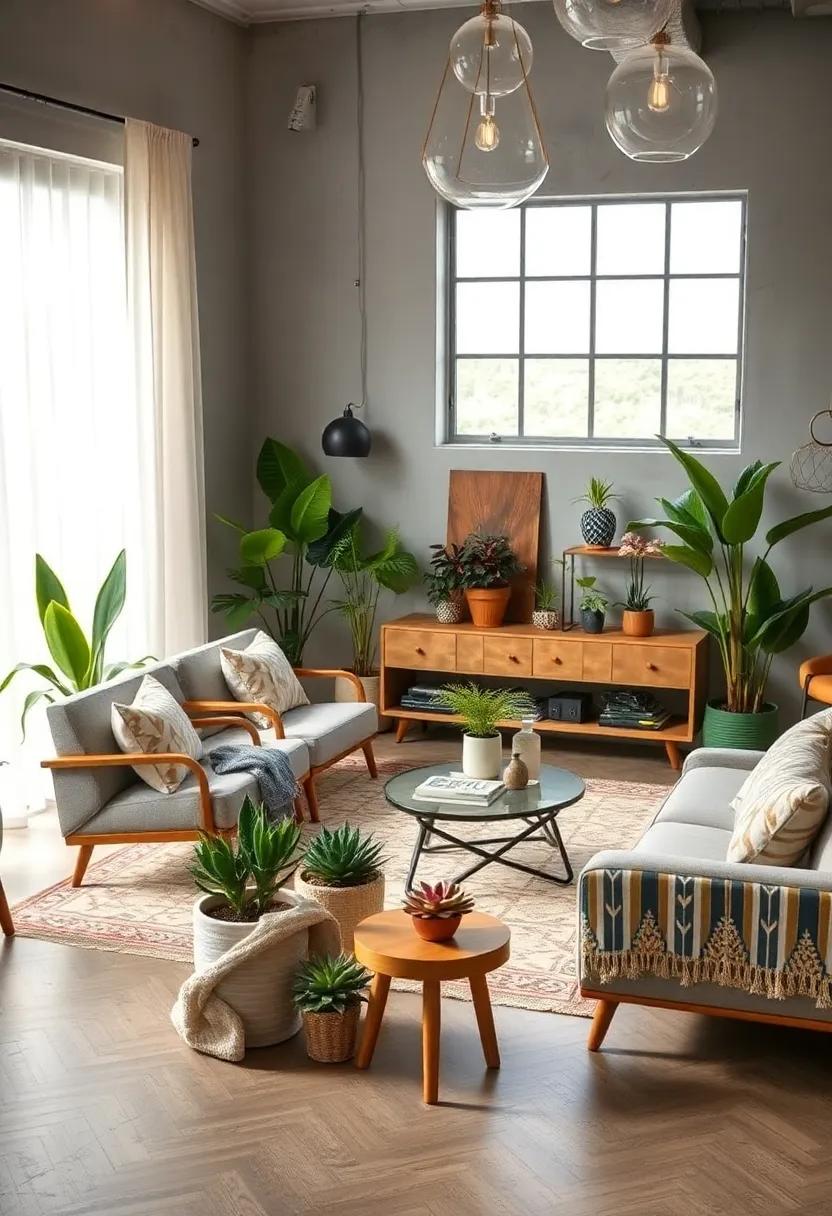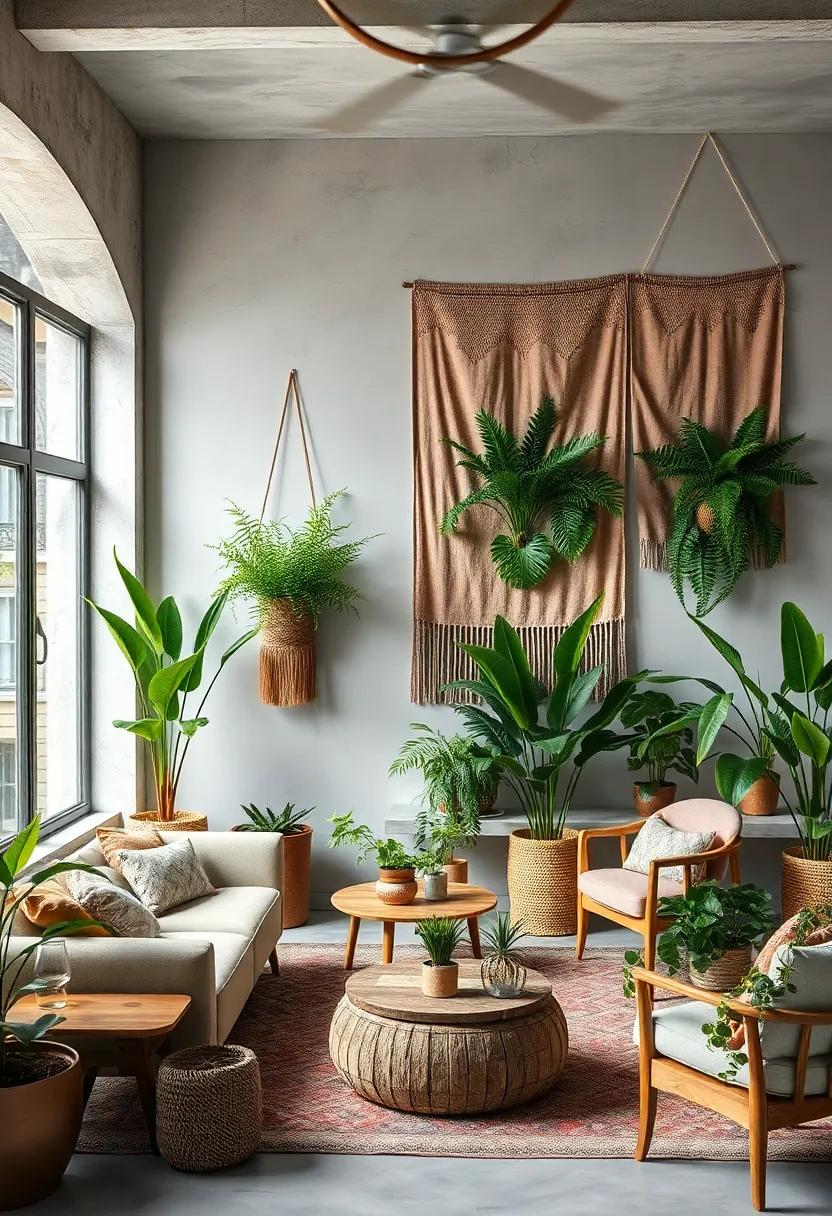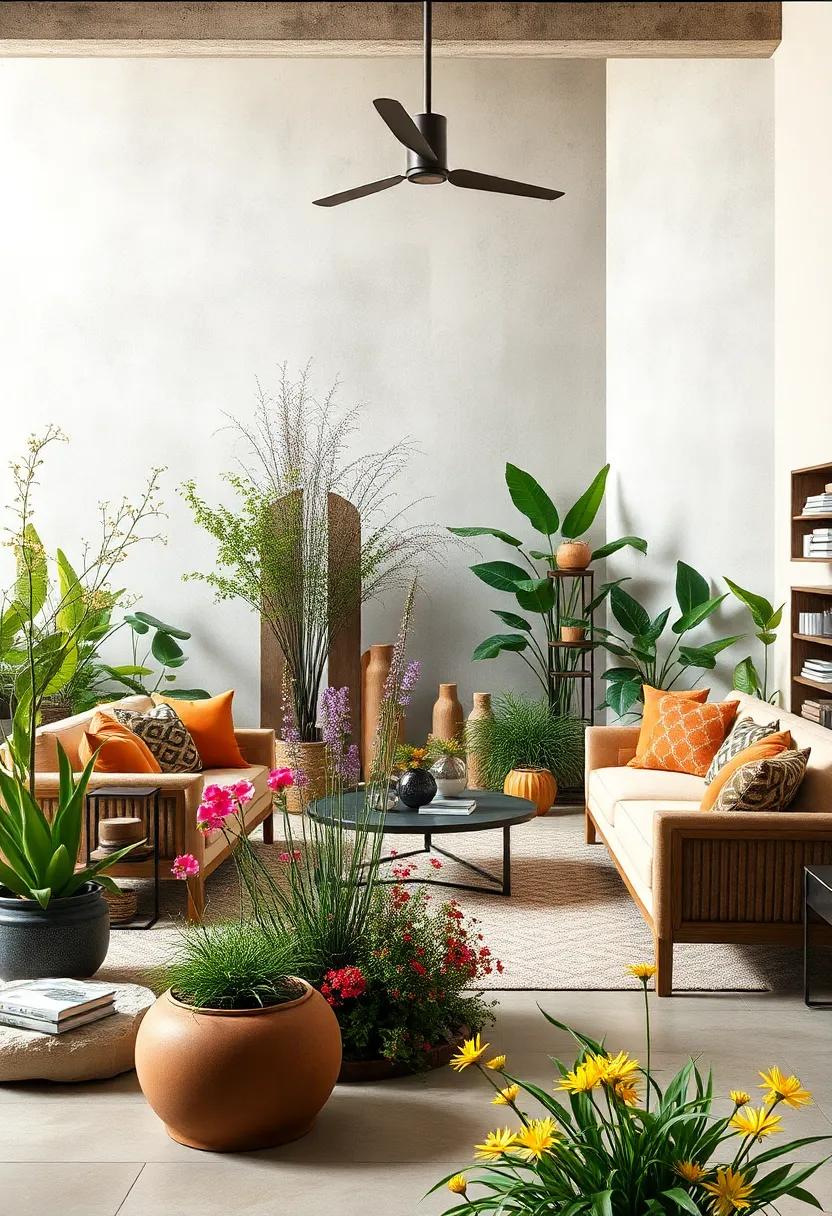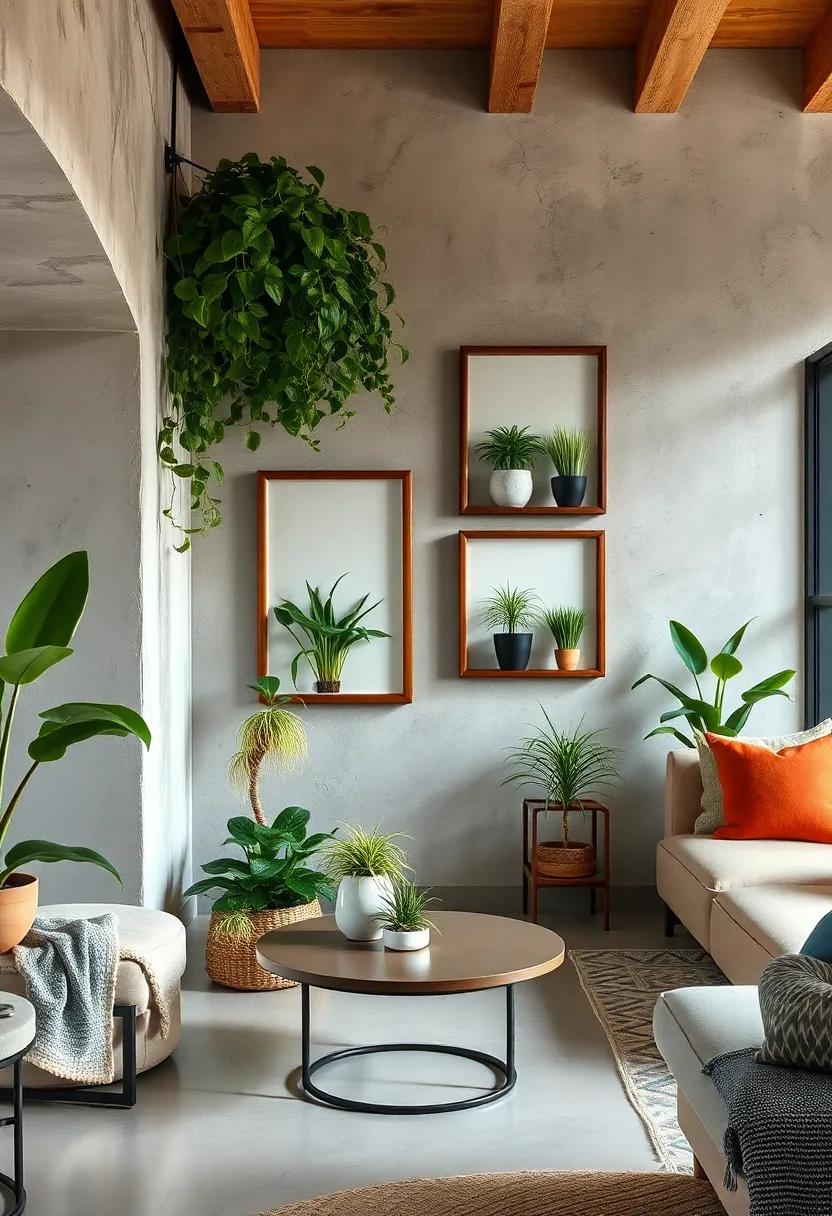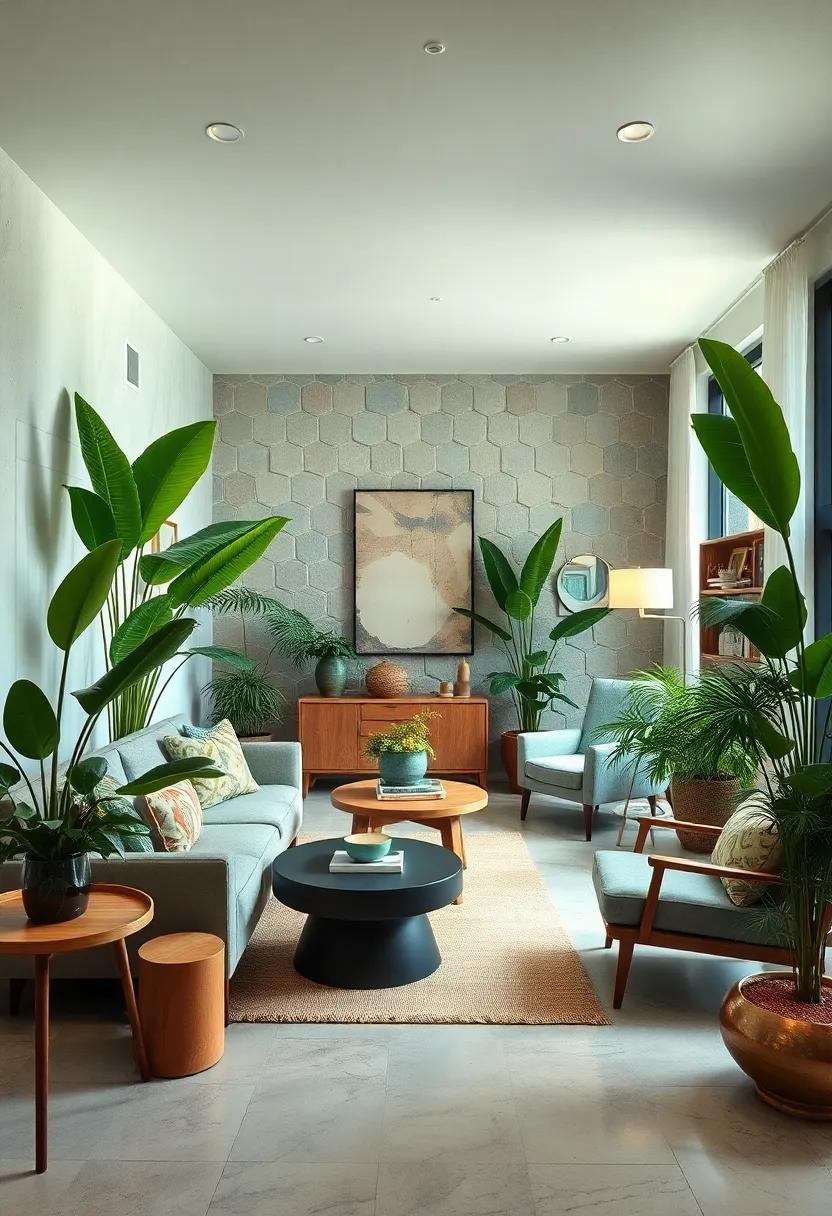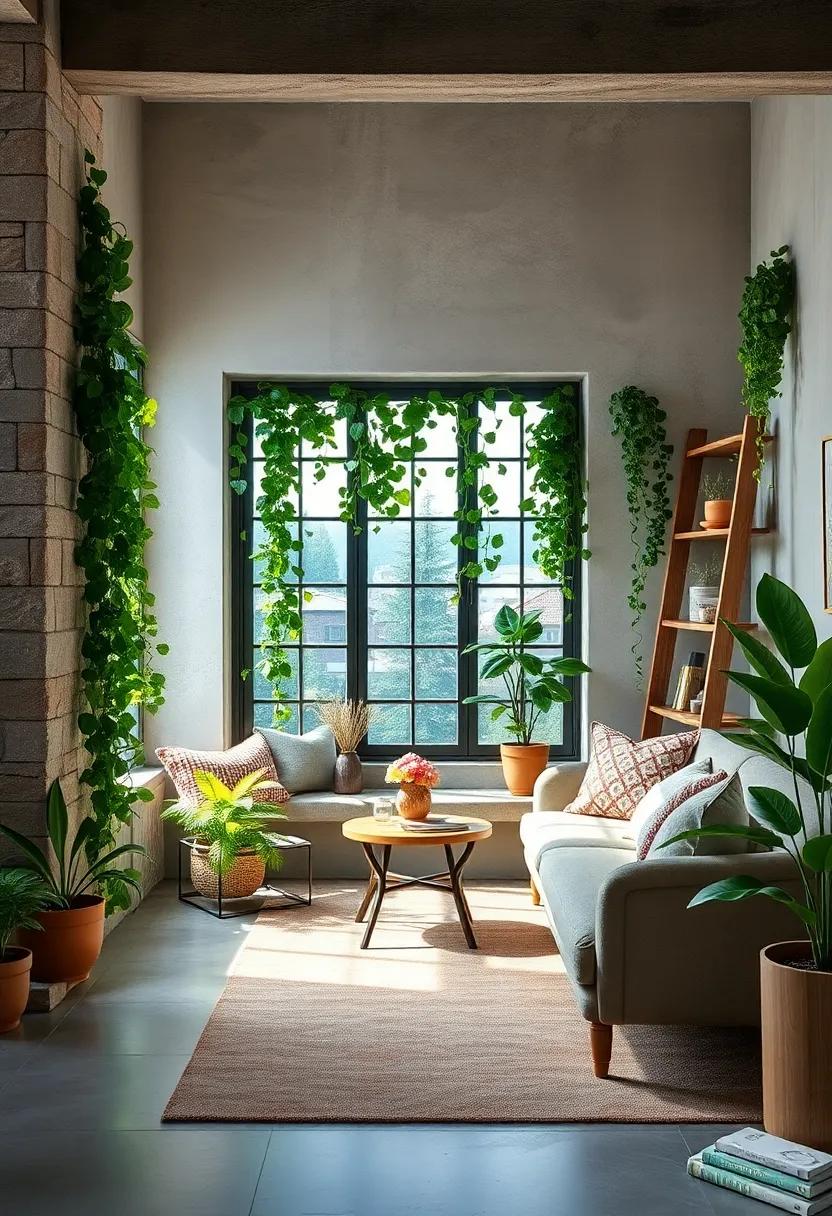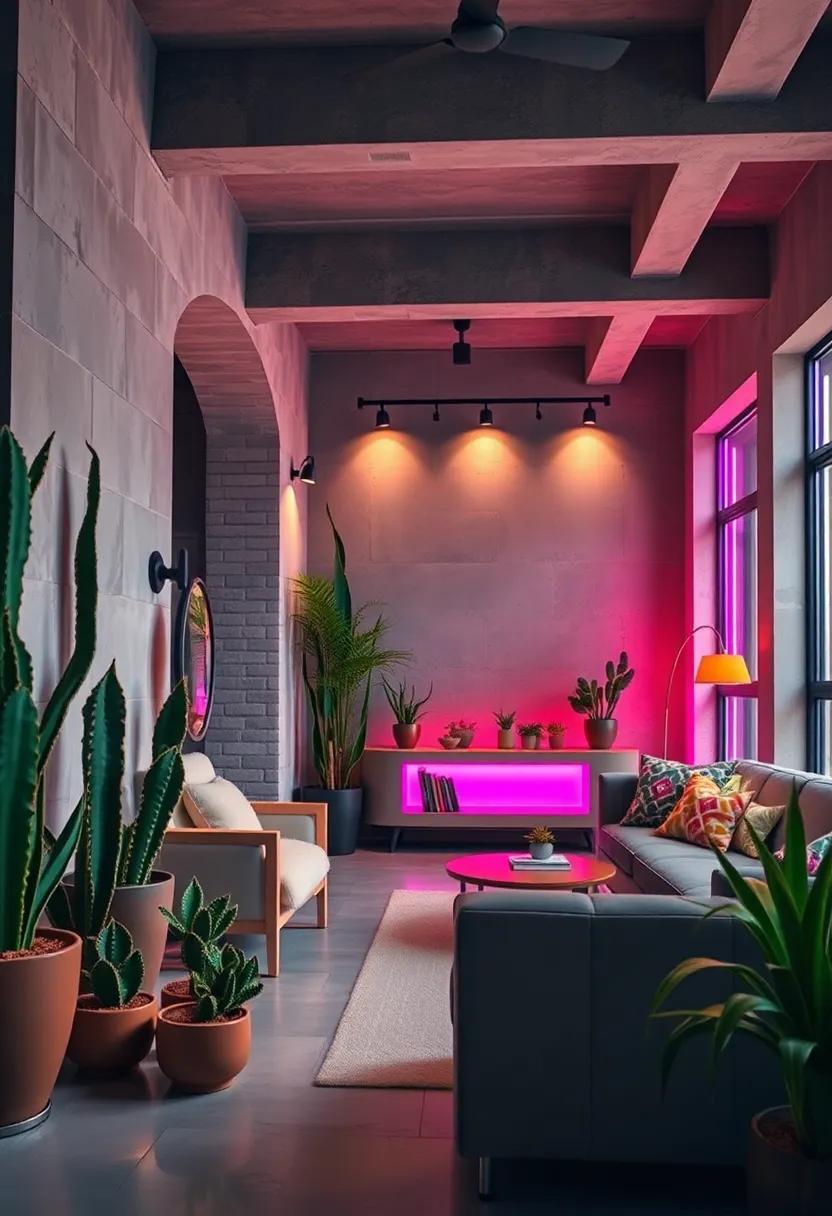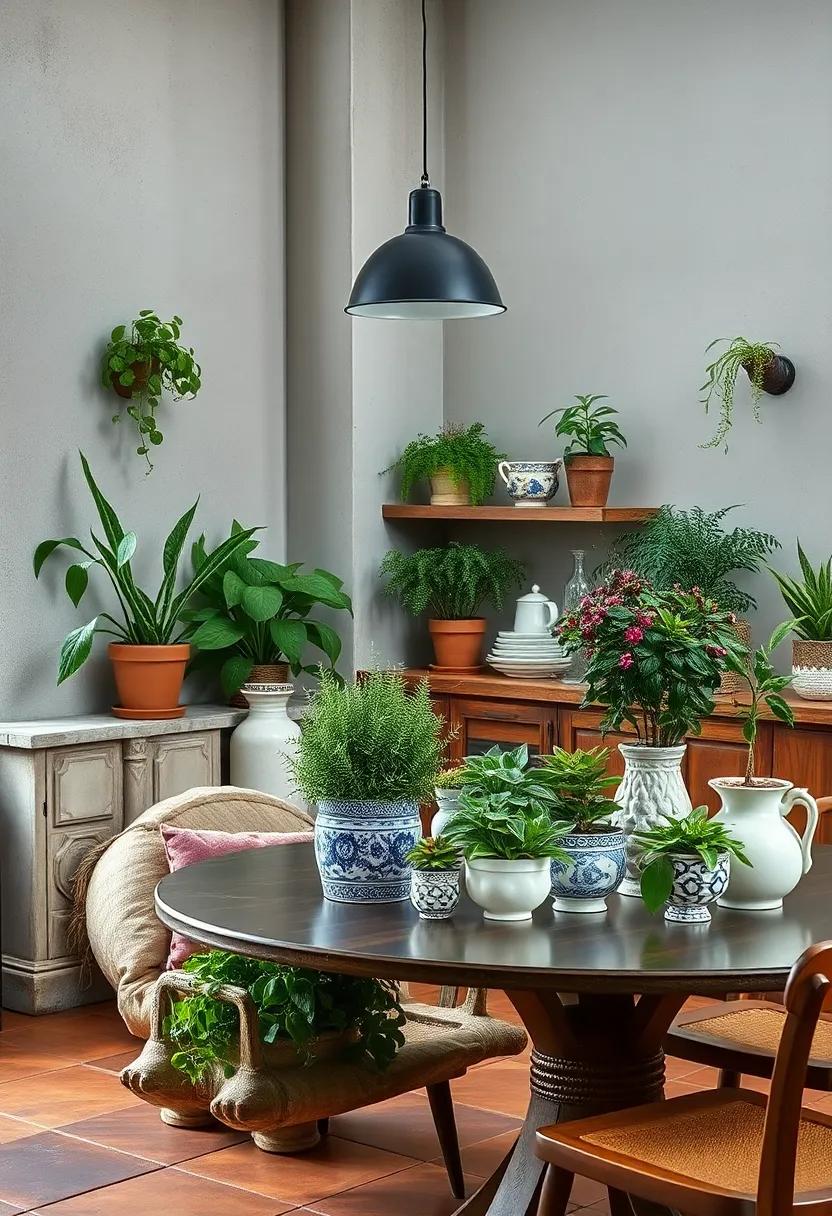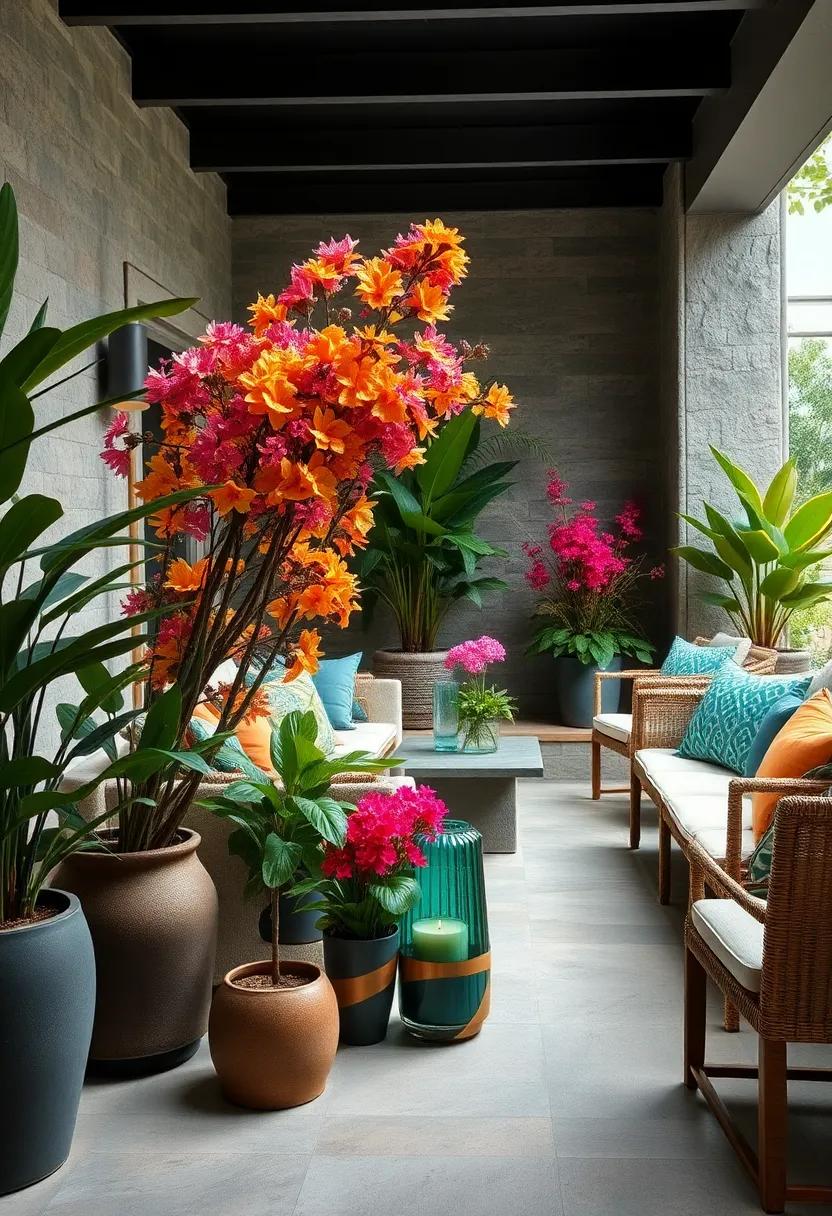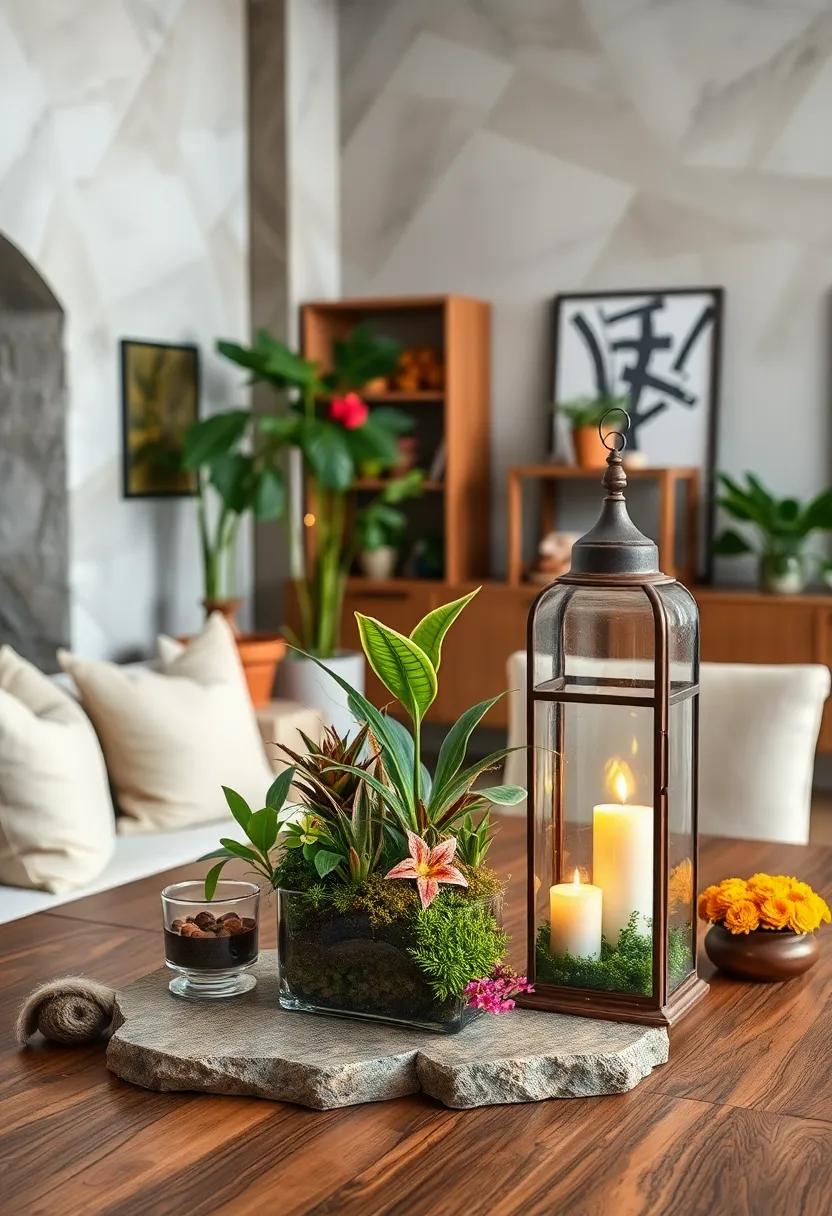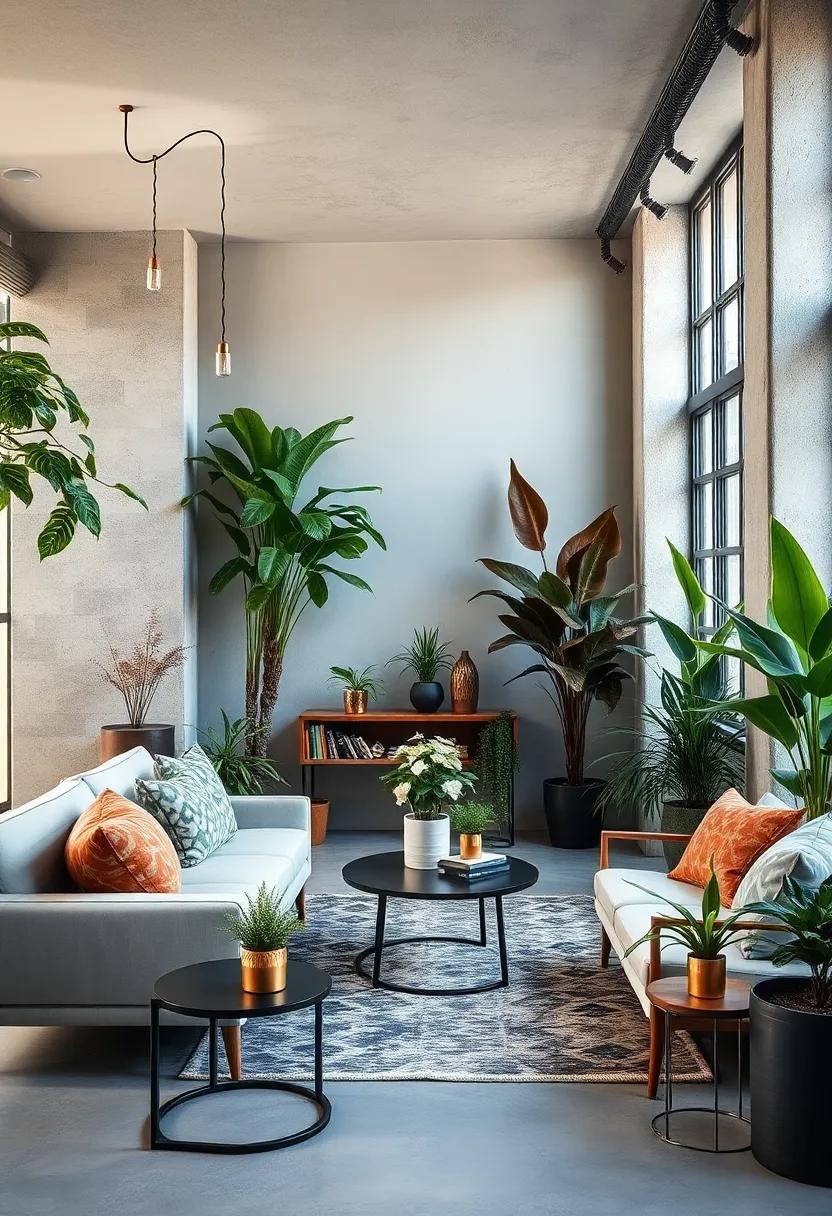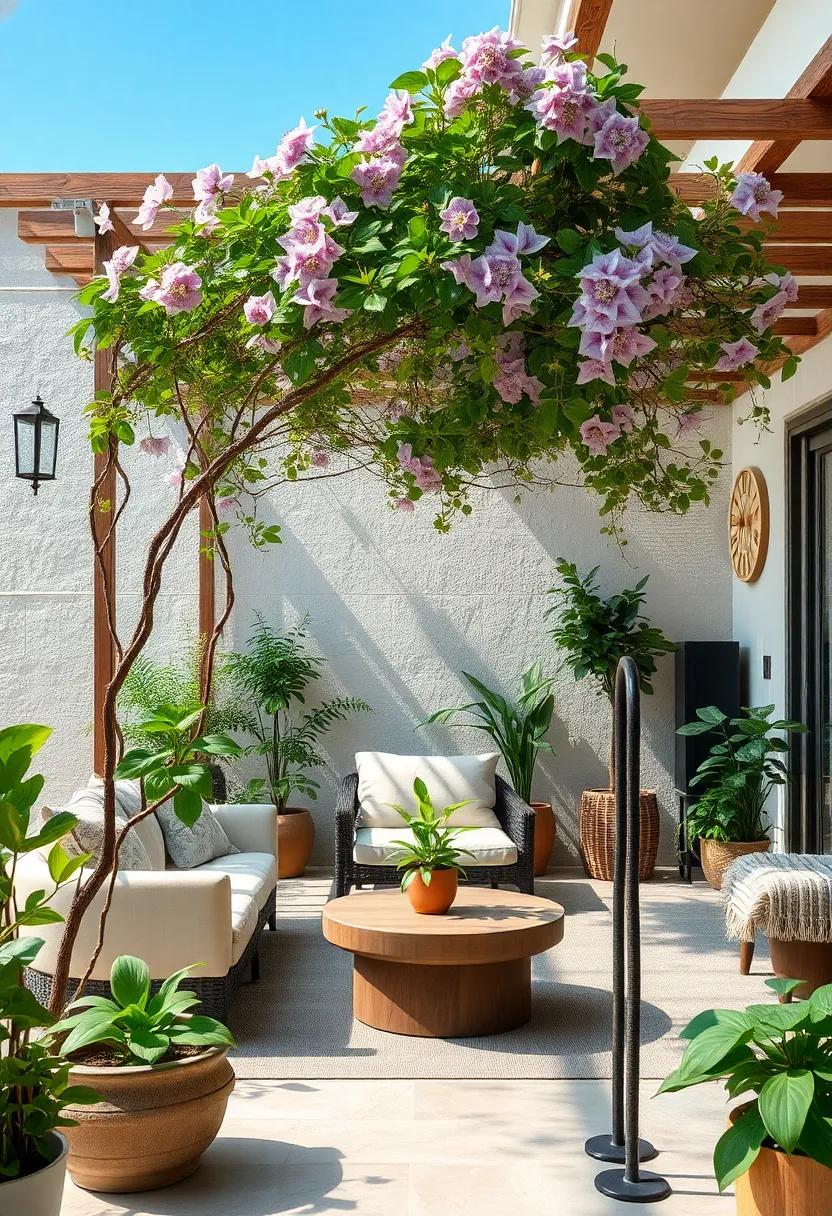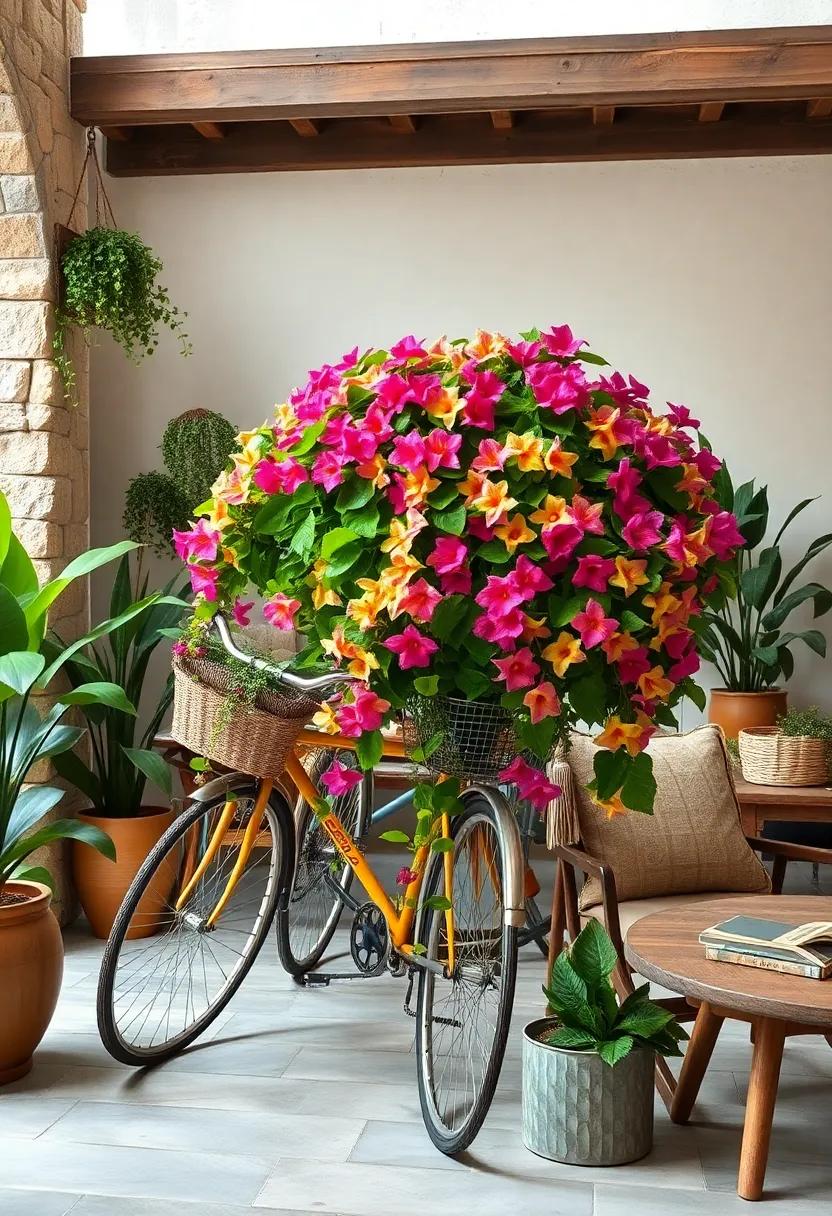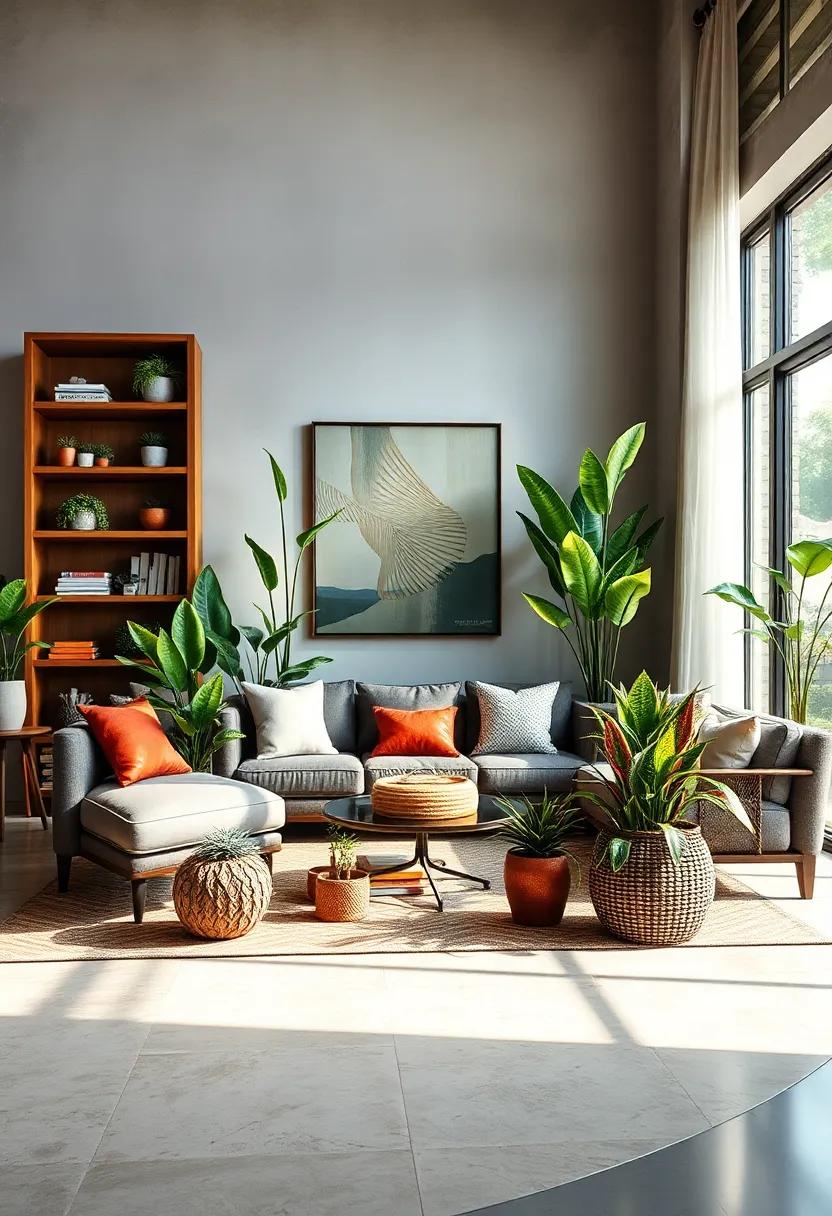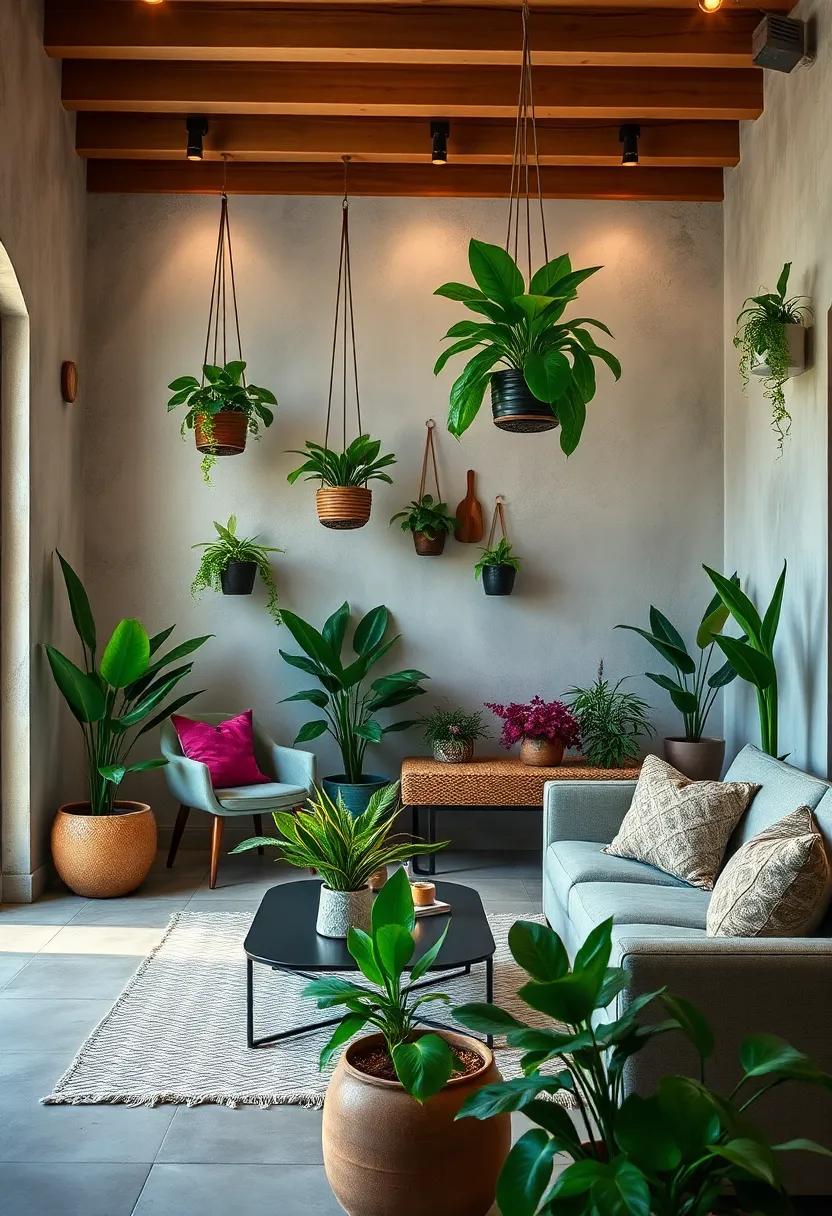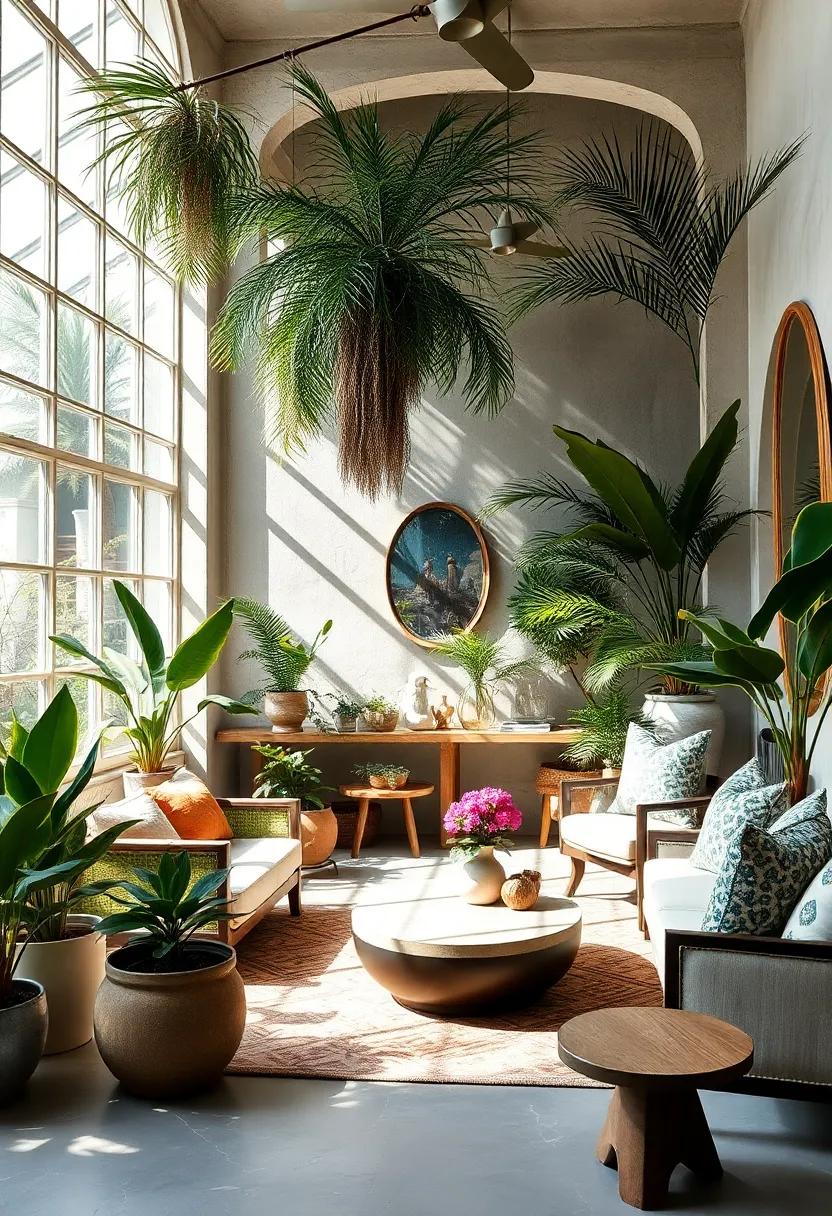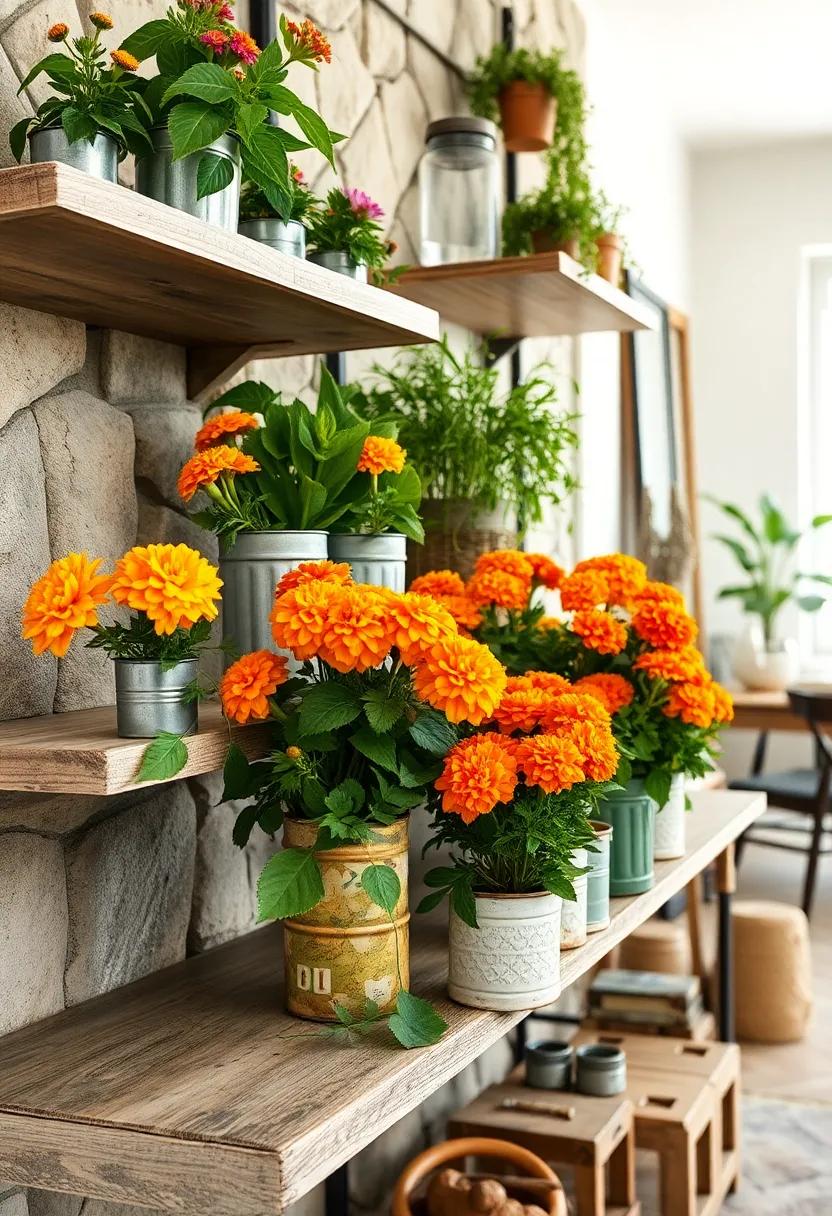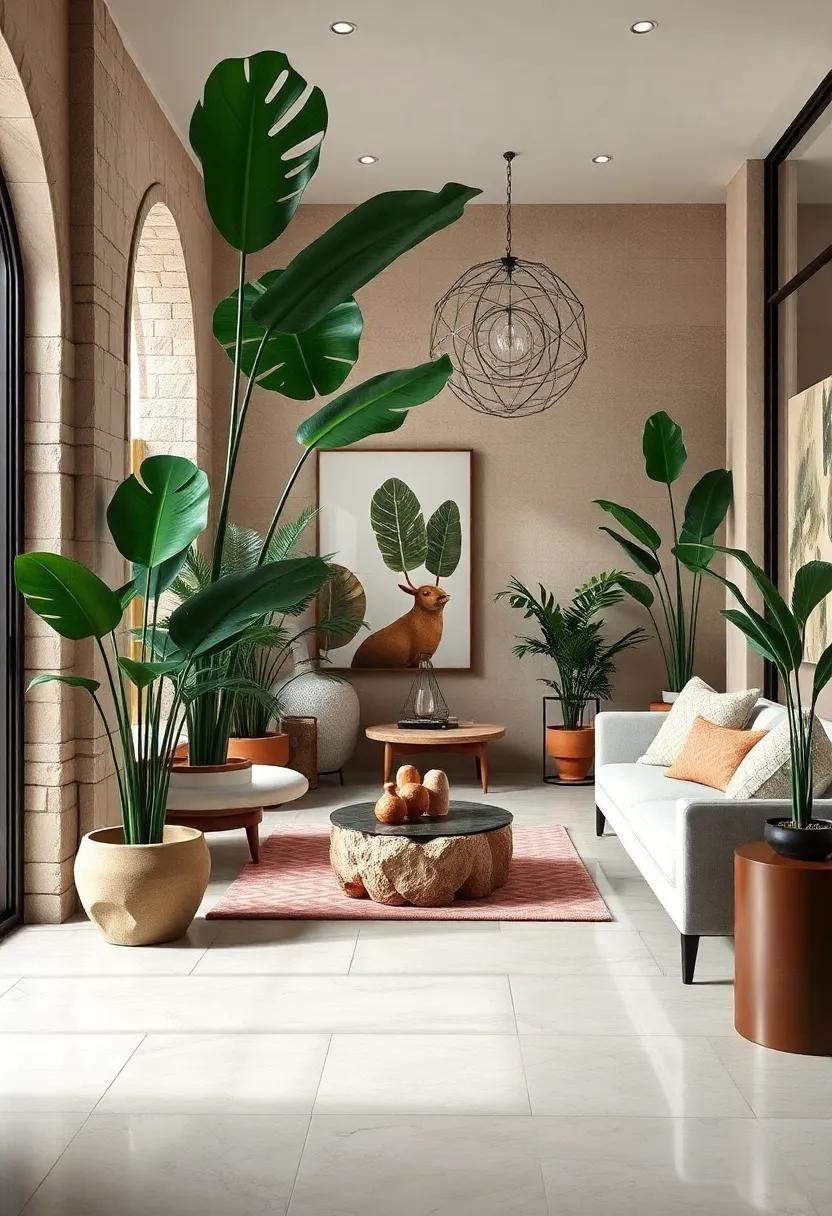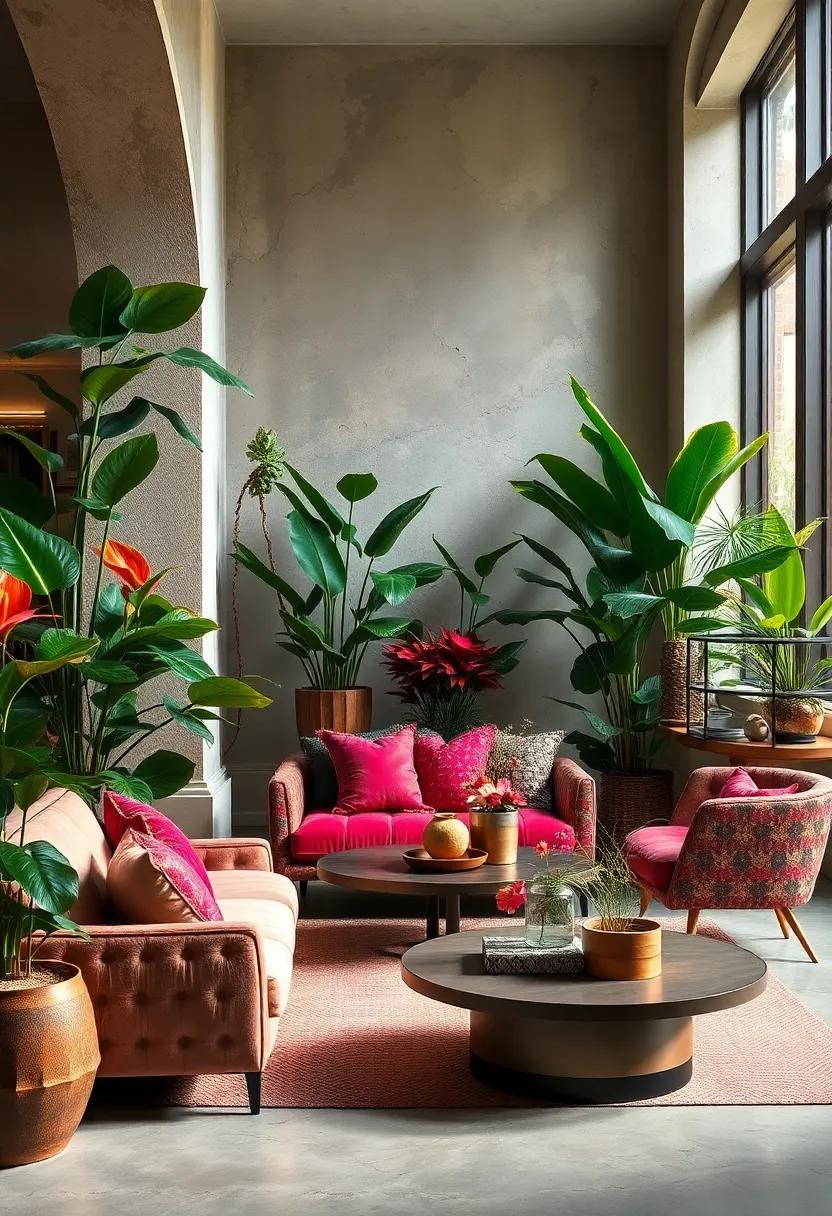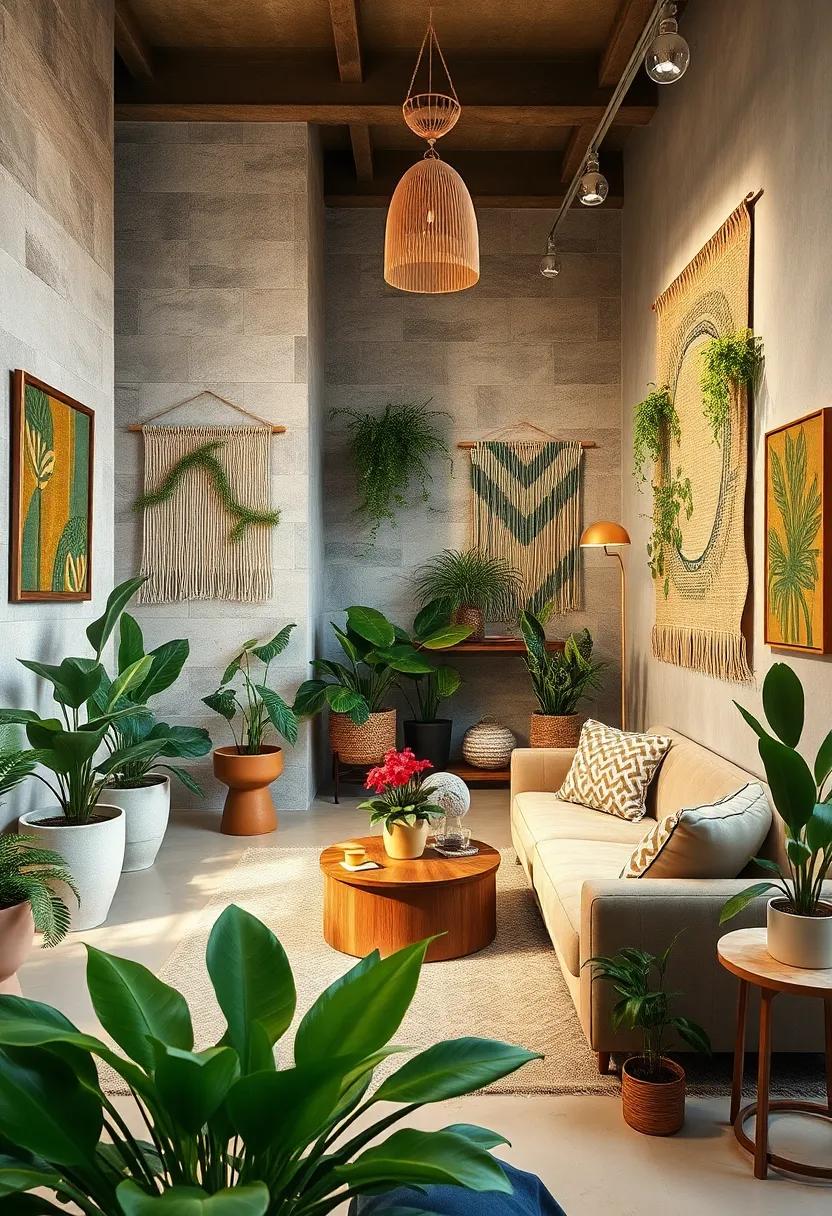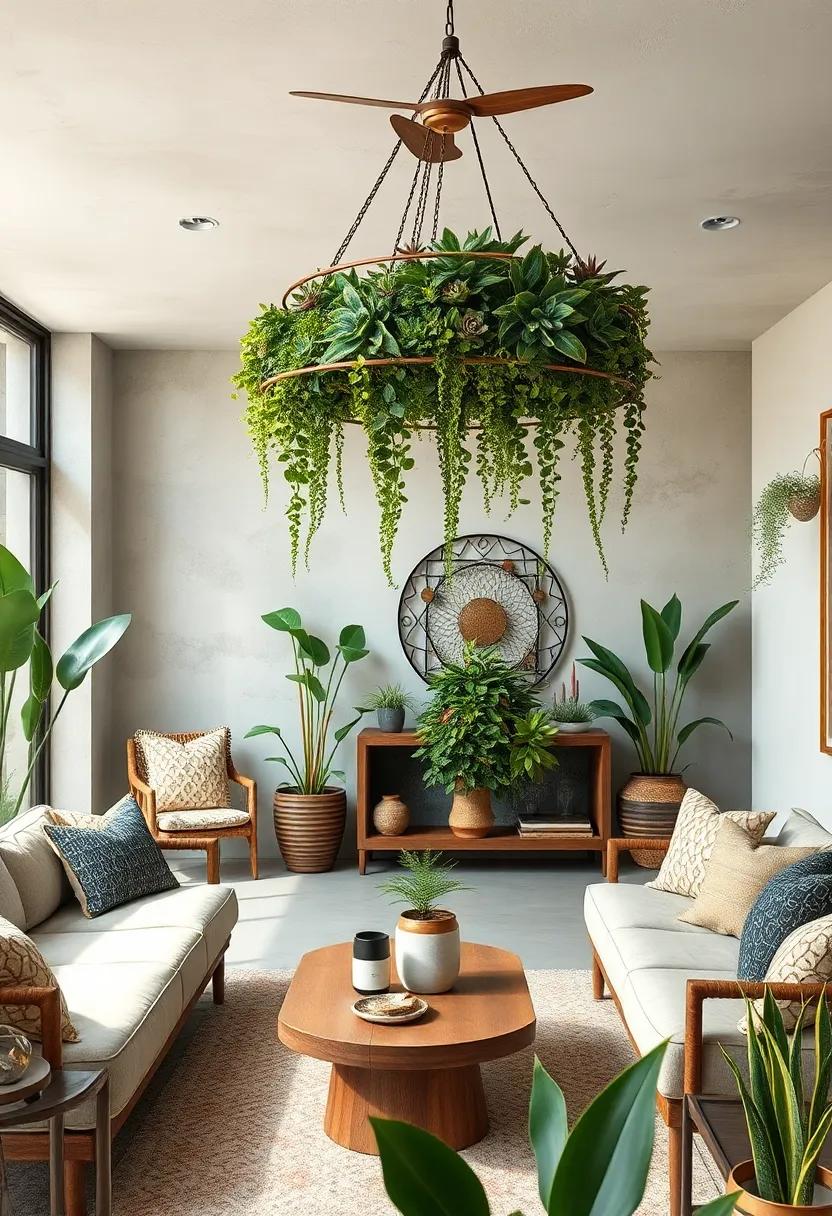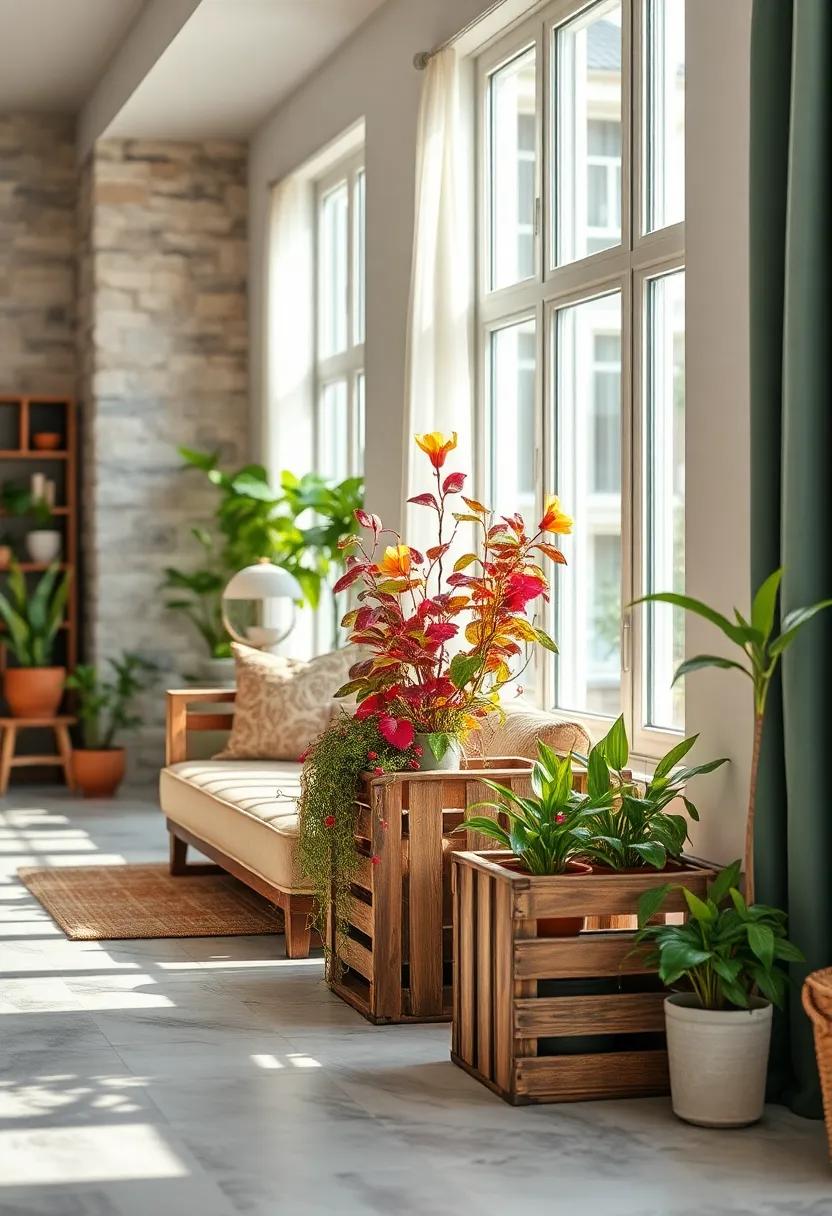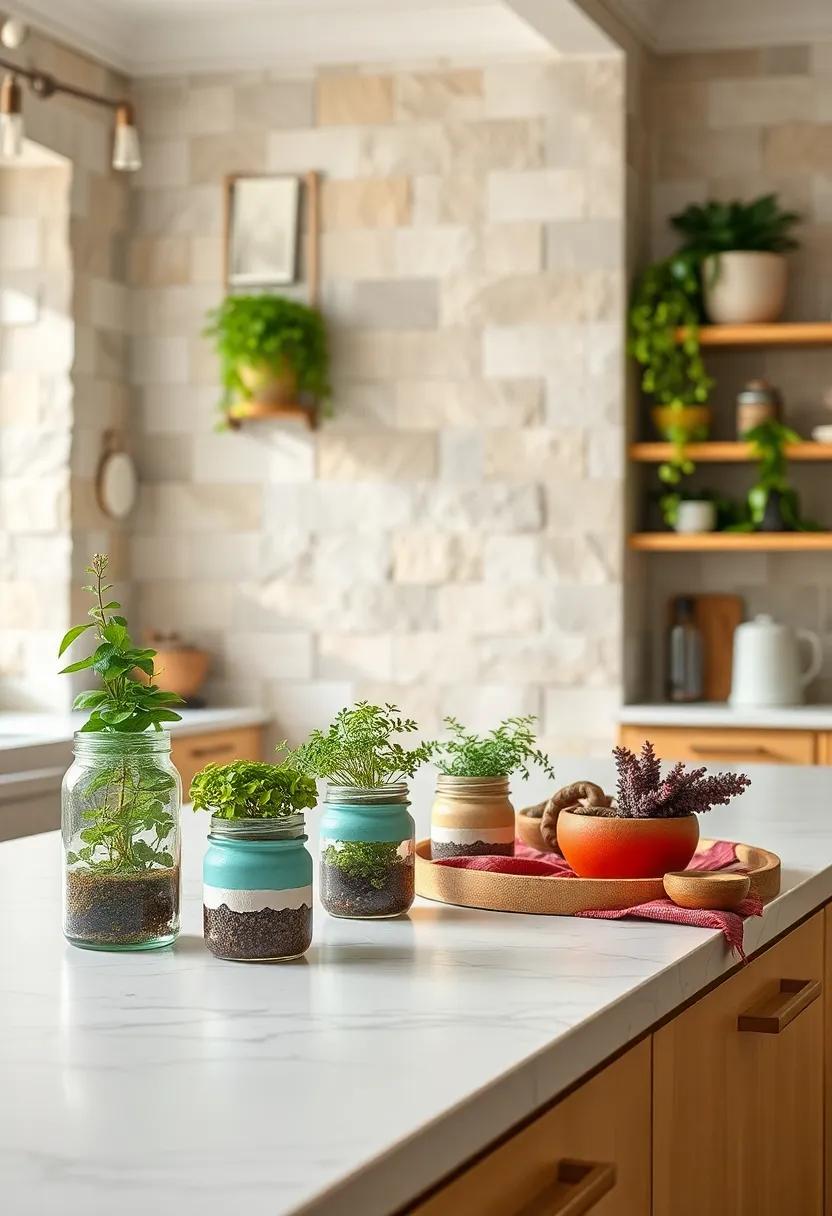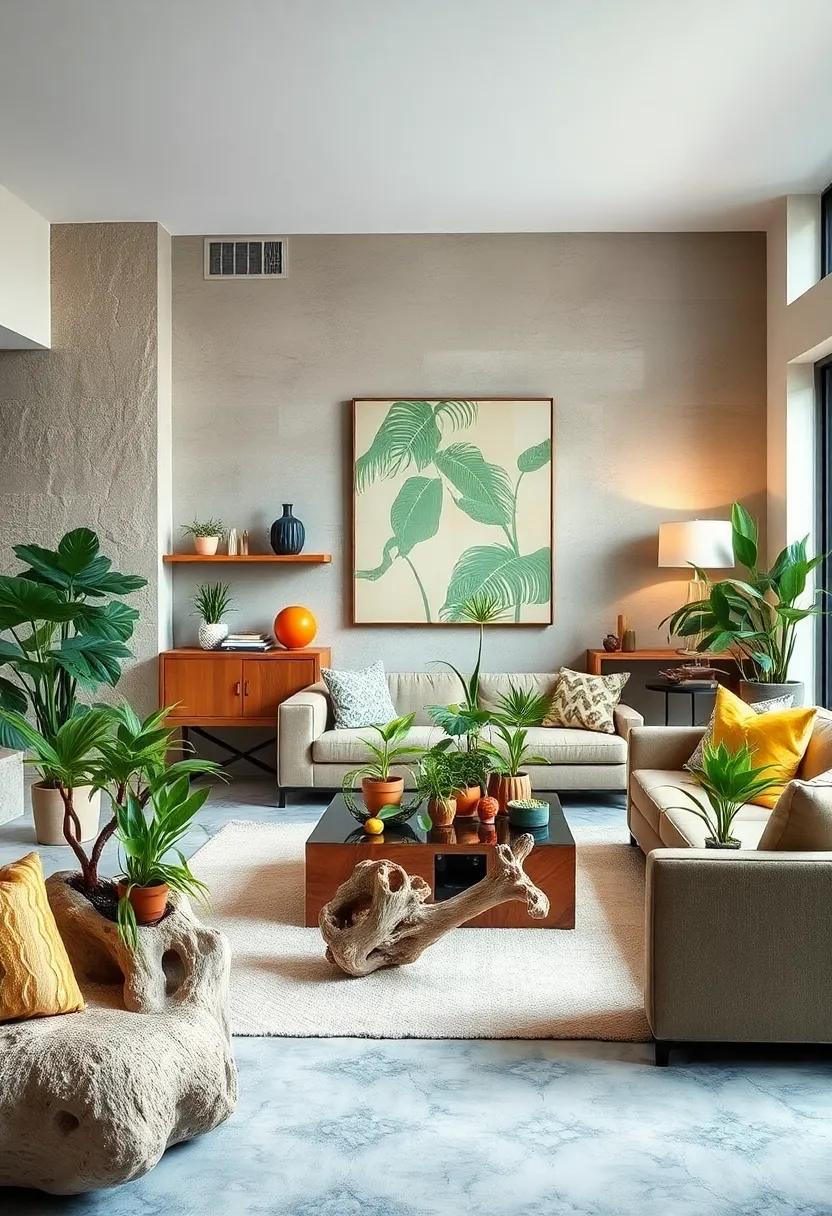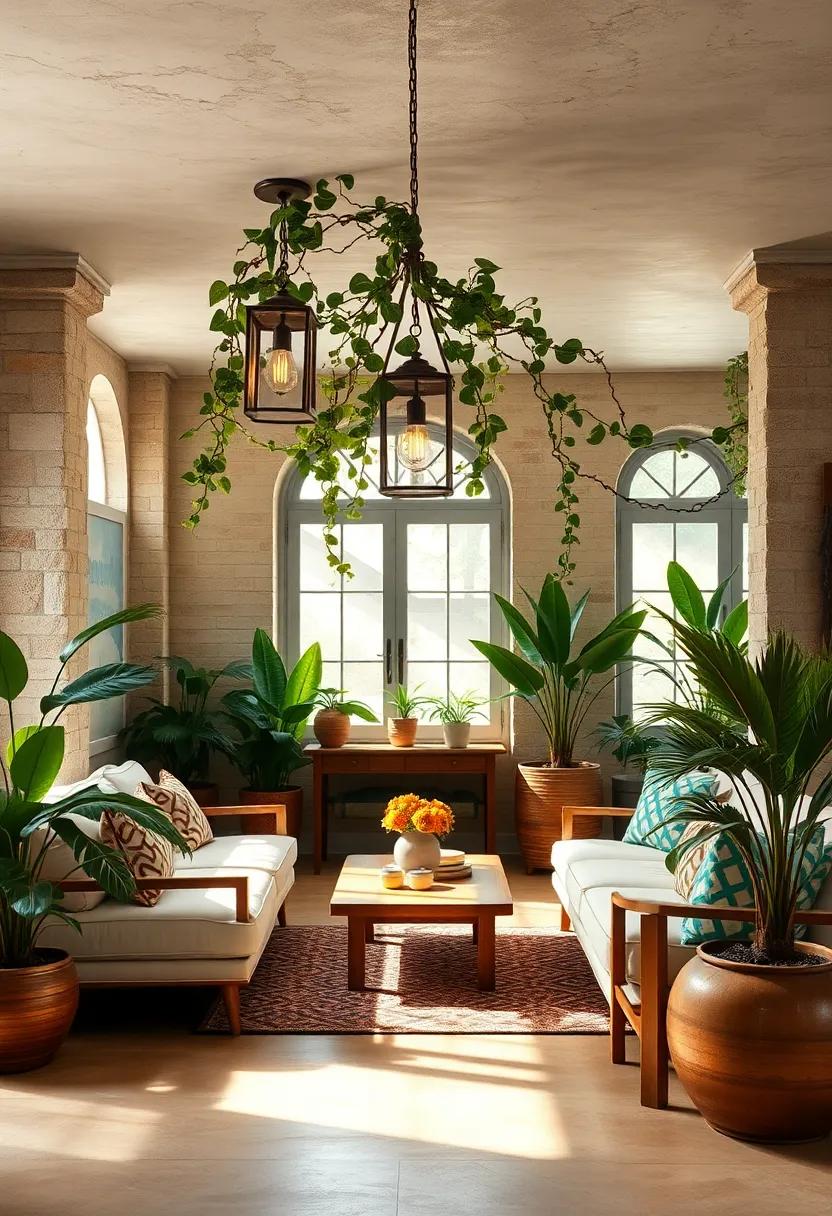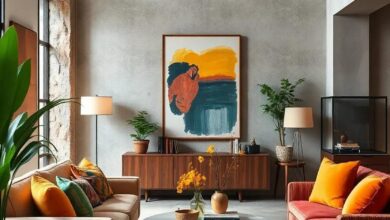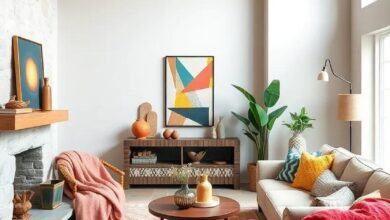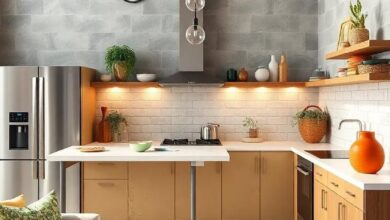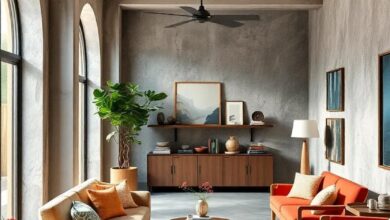Growing Eclectic: Innovative Ways to Weave Plants into Unique Designs
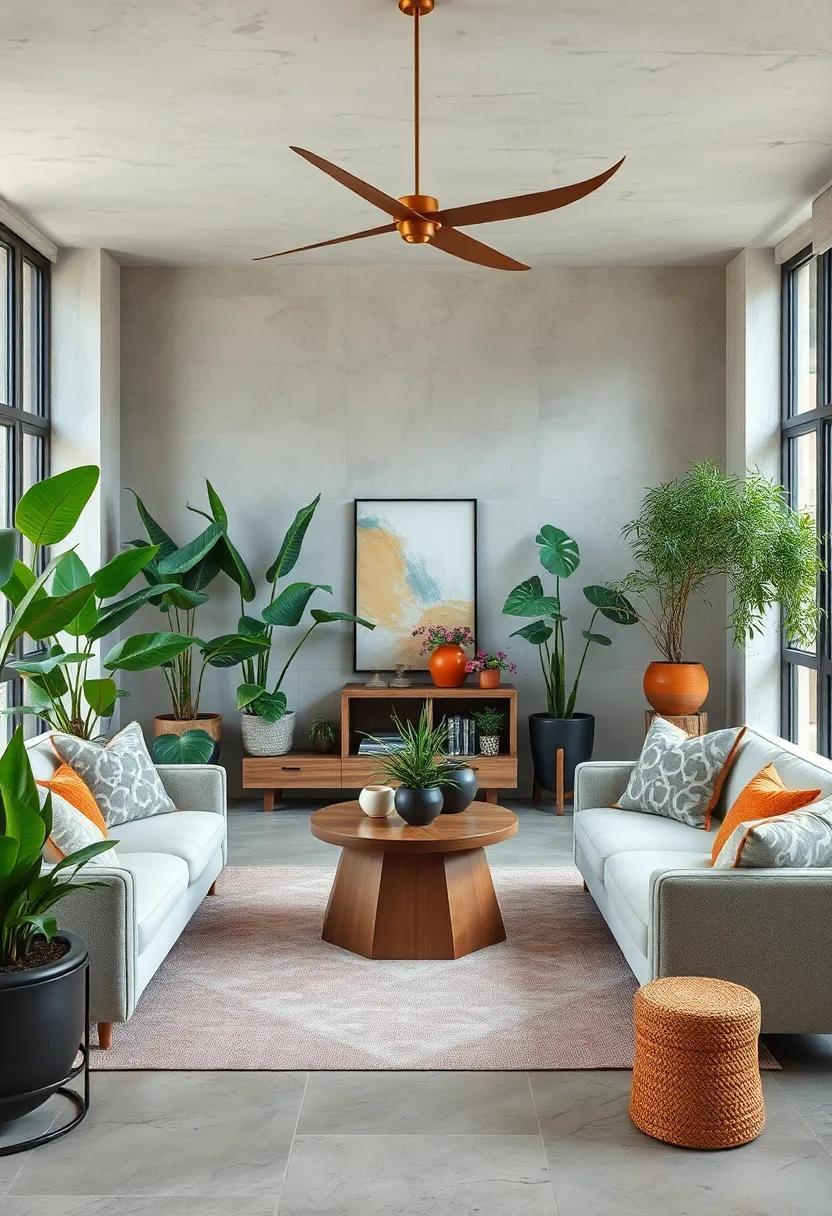
In a world where creativity blooms alongside nature, the art of incorporating plants into design has evolved far beyond traditional pot arrangements. “” explores the vibrant intersection between greenery and imagination, revealing how flora can transform spaces in unexpected and captivating ways. From living walls that breathe life into urban interiors to sculptural plant installations that challenge the boundaries of conventional décor, this journey celebrates the harmony of natural elements with artistic expression, inviting readers to rethink how plants can shape the environments around us.
The Art of Blending Succulents into Modern Geometric Patterns for Vibrant Indoor Atmospheres
Integrating succulents into geometric patterns transforms simple indoor spaces into living artworks that pulse with energy and life. By carefully selecting varying sizes and shapes of succulents-ranging from rosette echeverias to spiky haworthias-you can compose visually striking arrangements that mimic hexagons, triangles, or grids. This deliberate contrast of organic textures with sharp, symmetrical lines enhances the vibrancy of any room, creating a balanced tension between nature and design. Using modular containers or magnetic wall planters facilitates these dynamic shapes while allowing for easy rearrangement, fostering an evolving botanical display that responds to your space and mood.
To master this approach, consider these creative tips:
- Mix succulents with contrasting leaf colors-like deep burgundy with muted greens-to amplify the pattern’s depth.
- Incorporate geometric terrariums or wall-mounted pots that align with your chosen shape for added structure.
- Experiment with layering levels in vertical gardens to produce compelling 3D effects within the pattern.
Additionally, a simple guideline table can help maintain harmony between plant types and geometric styles:
| Pattern | Recommended Succulents | Visual Effect |
|---|---|---|
| Hexagonal | Echeveria, Sedum | Balanced, honeycomb rhythm |
| Linear Grid | Haworthia, Aloe | Sharp, contemporary structure |
| Triangular | Crassula, Sempervivum | Dynamic, angular movement |
This curated approach not only nurtures your plant collection but also elevates the entire ambiance, making your indoor atmosphere vibrant and uniquely alive.
A Symphony of Ferns and Vintage Fabrics in Eclectic Bohemian Wall Hangings
Imagine cascading ferns entwined with the tactile charm of vintage fabrics, creating wall hangings that speak of nostalgia and nature in harmonious dialogue. These eclectic bohemian creations celebrate imperfection, weaving together the soft curl of dried fronds with the textured stories told by aged lace, embroidered cotton, or timeworn tapestries. The resulting artwork becomes a living tapestry-part greenery, part textile-that adds both an organic vibe and a sense of history to any space. Using naturally dyed fabrics or hand-sewn patchworks alongside the chosen flora enhances the depth and sensory appeal, inviting viewers to both see and feel the layers of craftsmanship.
- Incorporate pressed fern leaves between transparent textile panels for light-catching effects.
- Mix moss yarn weaving with frayed lace for tactile richness.
- Use reclaimed fabric scraps to form a bohemian patchwork frame around fresh or preserved plant elements.
Below is a simple guide to pairing some of the most evocative fern varieties with complementary vintage textile types for your eclectic wall pieces:
| Fern Variety | Fabric Type | Textural Effect |
|---|---|---|
| Boston Fern | Linen | Soft, airy weave enhances fern’s fluffiness |
| Maidenhair Fern | Vintage Lace | Delicate contrast highlights fragile leaves |
| Staghorn Fern | Denim | Rugged texture pairs with bold fronds |
By thoughtfully combining flora with fabric, you create not merely décor but a tactile story of growth and memory-each piece a unique symphony of color, texture, and life.
Vibrant Wildflowers Weaving Through Abstract Metal Sculptures in Urban Gardens
Urban gardens have become unexpected canvases where vivid wildflowers blend effortlessly with cold, abstract metal sculptures, creating a captivating dialogue between nature and industrial art. These wild blooms, with their spontaneous, untamed beauty, soften the rigid lines and striking geometries of steel frames, while the metal works lend a modern edge to colorful floral tapestries. This harmonious interplay not only enlivens neglected city spaces but also invites passersby to appreciate the fusion of organic growth and artistic structure.
To enhance these installations, consider incorporating:
- Climbing vines: Grape or morning glory vines weaving up metal columns add vertical layers of texture.
- Modular planter boxes: Suspended or attached to sculptures create pockets of greenery that punctuate the steel forms.
- Seasonal wildflower mixes: Ensure continuous color shifts that adapt with the changing urban seasons.
| Wildflower Species | Preferred Light | Height Range |
|---|---|---|
| Black-eyed Susan | Full Sun | 2-3 ft |
| Coreopsis | Full Sun to Partial Shade | 1-2 ft |
| Butterfly Weed | Full Sun | 1-3 ft |
Crafting Living Portraits with Air Plants and Retro Frames for Eclectic Home Decor
Transform your walls into botanical galleries by combining the quirky charm of retro frames with the delicate beauty of air plants. These living portraits bring a breath of fresh creativity to any space, offering a dynamic take on wall art that evolves over time. The lightweight, soil-free roots of air plants thrive nestled within vintage windowpanes, ornate gold frames, or minimalist mid-century designs, making them the perfect centerpiece for eclectic interiors that celebrate contrast and character.
To get started, select frames with varying textures and finishes-matte black, weathered wood, or vibrant enamel work wonders. Mount a breathable mesh or cork backing to support the air plants without compromising airflow. For added flair, accentuate your arrangements with natural elements like driftwood, polished stones, or strips of Spanish moss. Incorporate these ideas effortlessly:
- Mix and Match: Combine multiple frame sizes and styles for a layered effect.
- Seasonal Rotations: Swap out plants or accessories with changing seasons.
- Subtle Lighting: Add soft LED strips behind frames to highlight the textures.
Fusing Tropical Plants with Mid-Century Modern Furniture to Create Bold Visual Statements
Infusing the vibrant life of tropical flora into the clean, angular lines of mid-century modern furniture can transform any space into a living gallery of color, texture, and form. The lush greens and sculptural shapes of plants like monstera, bird of paradise, and fiddle leaf fig add a soft, natural contrast to iconic pieces such as Eames chairs or sleek teak coffee tables. This dynamic pairing invites a fresh narrative, where nature and design converge, creating bold focal points that captivate and inspire. With thoughtful positioning, these verdant elements not only complement but elevate the furniture’s minimalist elegance, making each room feel intentionally curated and alive.
- Balance bold foliage with the simple geometry of mid-century pieces to achieve visual harmony.
- Incorporate varied pot styles such as matte ceramics or woven baskets that echo mid-century textures.
- Experiment with plant stands reminiscent of tripod or tapered-leg furniture, enhancing the retro-modern vibe.
| Plant | Mid-Century Pairing | Visual Impact |
|---|---|---|
| Fiddle Leaf Fig | Wooden Credenza | Sculptural and grounding |
| Bird of Paradise | Glass Coffee Table | Airy and vibrant |
| Monstera Deliciosa | Leather Lounge Chair | Textural and inviting |
The fusion of tropical greenery with mid-century modern design challenges the boundaries of traditional styling, breathing a sense of adventure and carefree spirit into interiors. By layering plant life as living sculptures around streamlined sofas and angular shelving, spaces become immersive environments where the organic and man-made speak in harmony. This approach nurtures a bold visual narrative that transcends trends, inviting continuous growth and evolution in the art of decoration. Every leaf and line tells a story, making every corner a destination of design exploration.
Lush Ivy Cascading Along Rustic Wooden Ladders for Cozy Window Nooks
Transforming a simple corner into a sanctuary of nature begins with selecting elements that evoke warmth and charm. Rustic wooden ladders, weathered by time, serve as the perfect framework to showcase vibrant, lush ivy that gracefully cascades down each rung. This harmonious blend of raw wood and greenery creates an inviting atmosphere, turning window nooks into cozy retreats where sunlight filters through leaves, dancing gently on textured surfaces. The ivy’s trailing tendrils soften the ladder’s rigid lines, inviting the eye to follow its natural flow and embrace the serene, organic aesthetic.
Creating these verdant displays is both an art and a science. Consider incorporating:
- Varied Ivy Species: Experiment with English ivy, Algerian, or variegated types to introduce subtle color shifts that add depth.
- Layering Techniques: Position smaller pots or moss-covered holders between ladder steps for a multi-dimensional effect.
- Ambient Lighting: Install soft LED string lights intertwined with the ivy to enhance evening coziness and highlight the intricate leaf patterns.
| Material | Benefit | Care Tips |
|---|---|---|
| Reclaimed Wood | Rustic charm, eco-friendly | Seal with non-toxic varnish |
| English Ivy | Hardy, fast-growing | Indirect light, moderate watering |
| String Lights | Ambient glow | LED preferred for low heat |
Daring Combinations of Cacti and Neon Accents in Futuristic Plant Display Concepts
Incorporating cacti into modern design layouts goes beyond their rugged charm when paired with vibrant neon accents. The contrast between the natural, spiky silhouettes and glowing hues creates an electrifying ambiance that captures the spirit of futurism. Imagine a sleek, matte black planter cradling a cluster of sharp, geometric cacti lit by LED strips in luminous pinks, greens, or blues; this not only enlivens the plant display but transforms it into a captivating centerpiece that fuses organic forms with cyber-inspired aesthetics.
Experimenting with lighting techniques can further enhance this dynamic visual dialogue. Consider layering translucent shelves or acrylic blocks to display cacti under neon glows, creating an interplay of shadows and reflections that intrigue the eye. Here are some creative ways to elevate this daring fusion:
- Floating neon rings: Suspended around cactus clusters, adding depth and mystique.
- Color-shifting planters: Using thermochromic paint or LED modulation for interactive effects.
- Mirror bases: Amplifying light and multiplying the visual impact of neon highlights.
| Neon Color | Cactus Variety | Suggested Setting |
|---|---|---|
| Electric Blue | Echinocactus grusonii | Minimalist lounges |
| Hot Pink | Astrophytum myriostigma | Urban cafés |
| Lime Green | Opuntia microdasys | Creative studios |
Mixing Edible Herbs with Antique Porcelain for Whimsical Kitchen Garden Vignettes
Infusing your kitchen garden with a touch of nostalgia and charm is as simple as intertwining aromatic herbs with graceful pieces of antique porcelain. Imagine delicate sprigs of thyme, sage, or mint spilling over the edges of vintage teacups, shallow saucers cradling tiny basil plants, or oregano thriving inside an ornate sugar bowl. These unexpected vessels not only serve as functional planters but also elevate the visual narrative of your green space, blending utility with an artful sense of history. The tactile contrast of smooth, cracked porcelain against lush greenery invites the eye and sparks curiosity, making each vignette a playful story to discover.
- Choose herbs with complementary growth patterns: trailing varieties like chives or creeping thyme pair beautifully with the delicate lines of teacups.
- Repurpose porcelain pieces with character: chipped rims and faded patterns add authenticity and charm to your garden tableaux.
- Incorporate mixed textures: moss, small pebbles, or a dash of soil garnish bring whimsical depth to each arrangement.
| Porcelain Vessel | Ideal Herb | Visual Impact |
|---|---|---|
| Vintage Teacup | Creeping Thyme | Delicate, trailing greenery |
| Sugar Bowl | Oregano | Full-bodied leafy texture |
| Creamer Pitcher | Mint | Bold, fragrant pops of green |
To truly capture a whimsical feel, place your porcelain planters at varying heights within your garden nook-on a reclaimed wooden tray, stacked vintage books, or nestled beside rustic kitchen tools. Each cluster becomes a miniature tableau, encouraging a sense of discovery. Don’t hesitate to mix in florals among your herbs for bursts of color that reveal how dynamic edible gardens can be. The timeless allure of antique porcelain lends itself beautifully to this creative layering, transforming simple herbs into charming keepsakes brimming with character.
Bright Blooms Entwined with Recycled Glass Objects for Eclectic Outdoor Installations
Imagine an eclectic outdoor retreat where vibrant floral bursts intertwine seamlessly with shimmering shards of recycled glass, creating a harmonious dance of color, texture, and light. This artistic fusion celebrates sustainability while transforming ordinary outdoor spaces into mesmerizing sanctuaries. Bright blooms, such as fiery reds and sunny yellows, thread their way through carefully arranged glass objects-each fragment catching the sun and scattering rainbows across the garden. This juxtaposition of organic softness and recycled resilience invites visitors to pause, explore, and appreciate the unexpected union of nature and repurposed art.
To help you design your own radiant installation, consider these key elements for combining living plants with recycled glass:
- Contrast in Texture: Use smooth or jagged glass pieces that complement the natural curves of petals and leaves.
- Color Play: Pair translucent glass tints with blossoms in analogous or complementary colors for visual harmony or bold statements.
- Structural Balance: Position heavier glass objects at the base for stability while letting vines and flowers entwine and soften the arrangement above.
- Sunlight Interaction: Arrange to catch light effectively, maximizing the sparkle of glass and vibrancy of blooms.
| Glass Object | Ideal Bloom | Effect |
|---|---|---|
| Blue Mosaic Pieces | Yellow Marigolds | Striking color contrast |
| Green Bottles | White Jasmine | Serene, fresh vibe |
| Clear Shards | Pink Petunias | Light-catching elegance |
Creating Miniature Jungle Terrariums Inside Antique Glass Lanterns for Unique Centerpieces
Transforming antique glass lanterns into lush miniature jungle landscapes offers an unexpected blend of nostalgia and vibrant greenery. These lanterns-once used to light the way-now cradle tiny ferns, mosses, and air plants beneath their glass panes, creating a delicate ecosystem that feels both ancient and alive. The interplay of light through the glass enhances the textures and colors, making each terrarium a mesmerizing focal point. To achieve the perfect balance, consider layering substrates with activated charcoal, a mix of potting soil, and small pebbles to maintain moisture while preventing rot.
Creating these unique centerpieces involves more than just plant selection; it’s about crafting a micro-habitat that thrives. When assembling your terrarium, keep these key tips in mind:
- Choose slow-growing plants that require minimal pruning.
- Incorporate decorative elements like tiny driftwood pieces or miniature animal figurines for added storytelling.
- Utilize the lantern’s natural ventilation by occasionally removing the top cover to regulate humidity.
The result is a captivating miniature jungle that invites closer inspection and elevates interior décor with its eclectic charm.
Blending Variegated Foliage with Industrial Elements for Striking Urban Plant Displays
When integrating plants with industrial design, the vibrant texture of variegated foliage creates an arresting contrast against sleek metal and concrete surfaces. Play with plants like Calathea Medallion whose intricate leaf patterns soften harsh lines, or the bold stripes of Ficus Pumila Variegata climbing rugged structures. This juxtaposition builds a striking dialogue between nature’s organic complexity and the minimalist austerity of industrial materials, inviting the eye to explore spaces with fresh admiration.
For urban installations, consider layering different variegated species in reclaimed metal containers or suspended wire grid planters, where leaf variegation functions as natural graphic art. Focus on combinations such as:
- Silver-edged Hostas paired with rusted steel beams
- Pink-Margin Tradescantia weaving through iron mesh panels
- Zebra-striped Sansevieria juxtaposed with raw concrete planters
| Plant | Variegation Type | Ideal Industrial Pairing |
|---|---|---|
| Calathea Medallion | Bold oval patterns | Brushed steel pots |
| Ficus Pumila Variegata | White margins on green | Rustic pipe frames |
| Tradescantia Zebrina | Pink and silver stripes | Wire mesh suspended |
Soft Moss Arranged Around Handcrafted Clay Pots in Serene Zen Garden Corners
Embracing the tranquil allure of a Zen garden, soft moss serves as an exquisite natural carpet, enveloping handcrafted clay pots with gentle, verdant hues. This fusion of textures-smooth, earthen pottery paired with lush moss-creates a tactile tableau that beckons quiet contemplation. The moss’s subtle variations in green softness highlight the rustic charm of each pot, making every corner feel like a living work of art where simplicity meets intentional design.
Design enthusiasts can explore various ways to amplify this calming interplay. Consider these elements as a starting point:
- Pattern play: Arrange clay pots in asymmetrical clusters that mimic the organic growth of mini-ecosystems, with moss weaving through as an unifying element.
- Textural contrast: Mix moss with coarse gravel or smooth river stones surrounding the pots, enhancing the sensory experience.
- Height variation: Position pots of varying sizes and stack low terraces enveloped with moss to add depth and dimension.
| Element | Effect | Care Tip |
|---|---|---|
| Moss | Soft texture, natural green hues | Keep moist, indirect light |
| Clay Pots | Earthy warmth, rustic charm | Regular cleaning, avoid waterlogging |
| Gravel | Coarse contrast, visual grounding | Keep free of debris |
Exotic Orchids Intersecting with Contemporary Abstract Art in Sophisticated Interiors
In sophisticated interiors where bold statements are welcomed, the juxtaposition of exotic orchids with contemporary abstract art fosters a dialogue of natural elegance and avant-garde vibrancy. These rare blooms, with their intricate shapes and vivid hues, mirror the dynamic brushstrokes and fluid forms found in modern abstract pieces, creating a symbiotic relationship between organic beauty and artistic expression. The subtle play of shadows and light on orchid petals enhances the visual depth of abstract canvases, while their living textures provide a tactile contrast to the often stark, geometric background. This blend invites a contemplative space where nature’s complexity amplifies contemporary creativity.
To integrate this fusion seamlessly, consider strategic placement and creative pairing:
- Layered Displays: Position orchids on sleek pedestals or floating shelves against a gallery wall, allowing flowers to peek through abstract forms.
- Color Echoing: Choose orchid varieties that reflect or complement dominant tones in surrounding artworks, enhancing visual harmony.
- Minimalist Containers: Use clear glass or matte black pots that do not compete with the complexity of both plant and art, emphasizing form and color.
| Orchid Variety | Abstract Style | Ideal Setting |
|---|---|---|
| Phalaenopsis | Fluid Expressionism | Curved walls or alcoves |
| Vanda | Geometric Abstraction | Corner nooks with spotlighting |
| Cattleya | Color Field | Open-plan living areas |
Draping Colorful Bougainvillea Across Vintage Cyclist Bicycles for Eclectic Garden Charm
Transforming vintage bicycles into vibrant, living canvases is a brilliant way to introduce playful elegance into your garden. Start by selecting weathered, wrought-iron or steel frames that carry the warm patina of time, which perfectly contrasts with the vivid, organically wild spirit of bougainvillea blossoms. Generously entwine the strikingly colorful vines so that they snake along the spokes, cradle the seat, and embellish the handlebars, creating a dynamic sculpture seemingly in motion even when at rest. This approach not only reclaims forgotten decor but also adds a whimsical texture and splash of color that instantly captivates visitors.
For an optimal blend of aesthetics and care, consider these key points:
- Placement: Position bicycles in sunny spots for abundant blooms.
- Support: Use soft ties or garden wire to gently anchor the tendrils.
- Maintenance: Prune regularly to maintain shape and prevent overcrowding.
- Surfaces: Paint or seal surfaces to protect metal from rust while complementing floral colors.
| Rustic Bicycle Type | Ideal Bougainvillea Color | Visual Effect |
|---|---|---|
| Antique Roadster | Magenta | Bold & Romantic |
| Classic Cruiser | Coral Pink | Soft & Inviting |
| Retro Kids’ Bike | Lavender | Playful & Whimsical |
Interweaving Spiky Bromeliads with Rustic Bookcases for Playful Living Room Accents
Introducing spiky bromeliads into the nooks of rustic bookcases can transform a simple shelving unit into a vibrant playground of textures and colors. Their architectural leaves inject a dynamic energy that contrasts beautifully with the worn wood grain, creating an eye-catching balance between nature and nostalgia. This fusion invites playful explorations, where books become the backdrop for living art, and green accents draw wandering eyes to unexpected corners of the room.
To achieve a harmonious blend, consider the following design tips:
- Vary the heights: Position bromeliads of different sizes to produce depth and interest.
- Mix textures: Pair the spiky foliage with soft fabric-bound volumes for tactile contrast.
- Create mini ecosystems: Incorporate small ornamental stones or ceramic figurines alongside plants for whimsical storytelling.
Contrasting Leaf Shapes and Textures in Hanging Planters for Dynamic Vertical Gardens
Combining varied leaf shapes and textures in hanging planters introduces an element of surprise and movement to vertical gardens. Imagine soft, feathery ferns playfully cascading beside bold, waxy elephant ear leaves. The contrast not only heightens visual interest but also brings a rhythmic balance, making the green wall come alive. Delicate, latticed leaves juxtaposed with robust, spiny foliage encourage the eye to travel, exploring every nook and cranny of your living wall.
To design such symphonies of foliage, consider pairing plants by contrasting their tactile qualities:
- Velvety vs. Glossy: Soft lamb’s ear leaves beside shining peperomias add depth through tactile variation.
- Compact vs. Flowing: Small, dense succulents set against trailing ivy create dynamic spatial layering.
- Flat vs. Rolled: Flat fiddle leaf figs offset by curly, rolled leaves of hoya make for quirky botanical conversations.
| Leaf Shape | Texture | Suggested Pairing |
|---|---|---|
| Heart-shaped | Velvety | Lush fern fronds |
| Elongated | Glossy | Trailing pothos |
| Curled | Spiny | Succulent clusters |
Sun-Lit Conservatories Filled with Mixed Palms and Antique Mirrors to Enhance Spaciousness
Bathed in natural light, these spaces transcend the typical greenhouse vibe by seamlessly blending lush greenery with reflections that amplify depth and dimension. Imagine the soft rustle of mixed palms-their varied textures and towering fronds-interplaying with the shiny surfaces of antique mirrors, creating a dynamic dance of shadows and light. This combination not only cultivates a serene sanctuary but also visually multiplies the area, making every corner feel expansively airy and inviting.
To optimize this enchanting effect, consider incorporating:
- Mirrors with ornate, vintage frames to add character and a sense of history.
- Diverse palm species such as the majestic Kentia, the spiky Majesty, and the dense Rhapis for layered greenery.
- Strategic placement of mirrors opposite seating areas or decorative elements to deepen the feel of the space.
- Natural stone or wooden flooring to ground the botanical display and enhance warmth.
| Palm Variety | Texture | Height Range |
|---|---|---|
| Kentia Palm | Feathery, elegant | 6-10 ft |
| Majesty Palm | Broad, spiky | 8-12 ft |
| Rhapis Palm | Dense, fan-shaped | 5-8 ft |
Bright Marigolds Arranged in Upcycled Tin Cans Along Weathered Farmhouse Shelves
Harnessing the charm of rustic textures, pairing blooming marigolds with salvaged tin cans brings an unexpected vibrancy to any indoor or outdoor space. These cheerful flowers thrive within their unconventional containers, whose rugged patina provides a striking contrast that amplifies the rich oranges and yellows of marigold petals. Nestling the cans on weathered wood shelves transforms a simple display into a storytelling vignette, where sustainability meets farmhouse nostalgia.
Consider the following elements for a captivating arrangement:
- Varied Heights: Stagger tin cans of different sizes to create visual rhythm along the shelf.
- Texture Contrast: Combine rough metal with the soft, feathery foliage of marigold plants.
- Natural Accents: Interleave sprigs of wild grasses or dried herbs between containers for a fuller, layered look.
| Aspect | Benefit | Tip |
|---|---|---|
| Metal Patina | Enhances vintage feel | Allow natural rust, seal lightly for longevity |
| Marigold Color | Brightens muted shelf tones | Choose mixed blooms for dynamic palette |
| Wood Shelf | Adds farmhouse warmth | Use reclaimed or distressed wood |
Rustic Branches Twisted with Blooming Clematis in Outdoor Pergola Canopies
Imagine stepping into a serene outdoor space where weathered branches entwine gracefully overhead, their natural curves forming a dynamic scaffold for bursts of vibrant clematis blooms. This marriage between twisted rustic wood and delicate floral tendrils transforms average pergola canopies into living works of art. To achieve this, start by selecting sturdy, naturally gnarled branches-ideally sourced from fallen limbs or reclaimed wood-which provide both structural integrity and a charming, timeworn aesthetic. As clematis climb and weave through these organic frameworks, their colorful flowers spill in clusters, creating an inviting canopy that dances with sunlight and shadow.
For optimal growth and design harmony, consider these essential elements:
- Branch Preparation: Secure and sanitize your branches to ensure longevity and prevent pest infestations.
- Clematis Variety: Choose cultivars with varied bloom times and colors for continuous seasonal interest.
- Support and Training: Gently tie young clematis shoots with soft garden ties, encouraging natural spirals around branches.
- Maintenance: Prune to balance growth and maintain aesthetic appeal without overpowering the rustic frame.
Combining Airy Grasses with Modern Ceramics for Textural Balance in Minimalist Spaces
Incorporating delicate airy grasses into modern ceramic displays introduces a compelling dialogue between softness and structure, perfect for minimalist interiors craving warmth without overcrowding. The lightness of grasses like Stipa tenuissima or Pennisetum alopecuroides creates movement and breathability, while the ceramics anchor the visual narrative with their clean lines and tactile surfaces. This interplay not only enhances textural contrast but also encourages a serene, balanced ambiance where natural and crafted elements converse harmoniously.
To cultivate this balance effectively, consider these styling tips:
- Monochromatic palettes: Choose ceramics in matte neutrals or soft pastels to let the grasses’ natural tones shine without visual competition.
- Varied heights: Play with vessels of diverse heights and shapes, from squat bowls to tall cylinders, to mirror the organic sway of the grasses.
- Minimalist placement: Group a few stems in small collections rather than dense bunches to maintain open negative space, enhancing the minimalist ethos.
| Grass Type | Ceramic Finish | Ideal Placement |
|---|---|---|
| Feather Reed Grass | Glossy White | Windowsill |
| Blue Fescue | Matte Concrete | Side Table |
| Fountain Grass | Terracotta | Bookshelf |
Vivid Anthuriums Nestled Among Velvet Upholstery for Rich Indoor Jungle Scenes
Imagine the striking contrast where the glossy, heart-shaped leaves of Anthuriums emerge gracefully against the sumptuous backdrop of velvet upholstery. This interplay not only elevates the tactile experience of your living space but also conjures a lush, indoor jungle imbued with richness and depth. The deep, saturated hues of velvet-ranging from emerald greens to royal blues and rich burgundy-amplify the vivid reds and pinks of Anthurium spathes, making each leaf and bloom pulse with life. To enhance this effect, consider pairing plants with upholstery that sports a matte finish, allowing the Anthuriums’ natural sheen to serve as living, breathing accents.
- Clustered heights: Arrange multiple Anthuriums of varying sizes alongside low velvet ottomans or chairs to create multi-dimensional layers.
- Textural Balance: Offset the smooth, waxy leaves with tufted or ribbed velvet textures to add visual intrigue.
- Color Sync: Select velvet curtains or cushions that pick up on the subtler hues of Anthurium foliage, such as dark green or muted coral.
| Element | Texture | Color Palette |
|---|---|---|
| Anthurium Leaves | Glossy, Smooth | Deep Green |
| Anthurium Spathes | Wax-like | Crimson, Soft Pink |
| Velvet Upholstery | Plush, Soft | Emerald, Burgundy, Navy |
Diverse Plant Species Interlaced with Handwoven Textile Art on Gallery Walls
Integrating a vibrant assortment of plants alongside handwoven textiles transforms gallery walls into living tapestries that celebrate both natural and artistic heritage. Imagine succulents, trailing ivies, and blossoming air plants delicately intertwined with textured fabrics, where each fiber echoes the organic patterns of leaves and vines. This harmonious fusion not only enlivens the space but also invites viewers to explore the subtle relationship between growth and craft. Curators and artists use this approach to breathe dynamic life into static exhibitions, creating multisensory experiences where texture meets tranquility.
To achieve this, consider these design elements which balance flora and fabric with effortless grace:
- Weave Patterns Mirroring Nature: Select textiles whose motifs reflect plant structures like veins, branches, or petals.
- Modular Plant Holders: Incorporate handcrafted baskets or macramé holders that complement the woven art, offering a seamless transition between medium and greenery.
- Color Coordinates: Choose plants and textiles in complementary or analogous color palettes, enhancing visual coherence across the installation.
- Layering Depth: Position textiles behind or slightly beneath flora to give a sense of dimensionality and movement to the arrangement.
| Plant Type | Textile Technique | Design Impact |
|---|---|---|
| Moss & Fern | Loop Pile Weaving | Soft, plush textures mimicking forest floors |
| Trailing Ivy | Fringe Detailing | Dynamic, flowing edges enhancing vitality |
| Orchid Blooms | Embroidery | Delicate, intricate highlights complementing blossoms |
| Air Plants | Knotting & Macramé | Organic structures fusing form and function |
Giant Monstera Leaves Paired with Polished Stone Accents in Chic Entryway Displays
Transform your entryway into a breathtaking fusion of nature and modern elegance by incorporating the bold silhouettes of giant Monstera leaves alongside sleek, polished stone accents. The oversized foliage, with its dramatic fenestrations and lush green hues, naturally commands attention, setting an organic tone that’s both inviting and sophisticated. When paired with smooth, reflective stones in neutral shades-such as marble, granite, or onyx-the leaves’ texture and vitality are accentuated, creating a harmonious contrast between the wild and the refined.
Consider arranging these elements with a few key design principles in mind:
- Balance: Use stones of varying shapes and sizes to ground the visual weight of the large Monstera leaves without overwhelming the space.
- Layering: Position leaves at different heights or depths to produce a dynamic, three-dimensional effect.
- Accent Lighting: Illuminate polished stone surfaces subtly to enhance their natural shimmer and highlight the foliage veins.
| Element | Suggested Material | Effect |
|---|---|---|
| Monstera Leaf | Fresh or Faux Leaves | Bold, Organic Texture |
| Polished Stone | White Marble | Elegant Gleam |
| Container | Matte Black Ceramic | Modern Contrast |
Hanging Succulent Gardens Dripping Over Raw Steel Frames for Edgy Outdoor Art
Embracing an industrial aesthetic with a touch of organic charm, these garden installations transform cold, raw steel frames into living sculptures. The steel structures serve not only as robust support but also as a dramatic backdrop for succulent varieties to cascade and intermingle, creating a dynamic visual conversation between metal and plant life. The juxtaposition of sleek, angular metalwork against the soft, fleshy textures of succulents generates a sense of balance that is both modern and timeless. This fusion breathes life into outdoor spaces, turning ordinary corners into alluring focal points.
When curating this type of display, consider these essential components for success:
- Plant Selection: Choose hardy, drought-tolerant succulents that thrive in vertical or semi-hanging arrangements.
- Frame Design: Opt for steel frames with geometric or abstract shapes to amplify the edgy appeal.
- Drainage & Soil: Ensure the use of well-draining soil mixes and incorporate irrigation channels within the frame.
- Maintenance: Regularly prune and rearrange plants to maintain shape and vitality.
| Succulent Type | Water Needs | Growth Habit | Color Palette |
|---|---|---|---|
| String of Pearls | Low | Trailing | Green / Pale Gray |
| Echeveria | Moderate | Rosette | Blue / Pink |
| Burro’s Tail | Low | Trailing | Gray-Green |
| Senecio Rowleyanus | Low | Trailing | Bright Green |
Colorful Vines Threaded Through Vintage Wooden Crates Creating Rustic Plant Pods
Imagine breathing new life into weathered wood by intertwining vibrant, colorful vines through the slats of vintage crates. This approach transforms neglected storage boxes into charming rustic plant pods, perfect for creating mini green sanctuaries in your living space. The crates serve as both planters and art pieces, showcasing the intricate dance between aged textures and lively greenery. The contrast between rugged wood and delicate foliage highlights nature’s persistence and beauty, inviting a tactile warmth into any room or outdoor nook.
To craft these rustic plant pods, consider these essential elements:
- Choice of Vines: Opt for trailing varieties like pothos, string of hearts, or ivy to cascade through crate slats seamlessly.
- Crate Selection: Hunt for crates with unique wood grains, weathered finishes, or interesting shapes to add character.
- Drainage Setup: Line crates with moss or coconut fiber to retain moisture while preventing water accumulation.
- Placement Tips: Position pods in indirect sunlight spots, allowing vines to thrive without overexposure.
| Vine Type | Growth Habit | Light Need |
|---|---|---|
| Pothos | Trailing | Low to bright indirect |
| String of Hearts | Delicate, hanging | Bright indirect |
| English Ivy | Climbing, spreader | Moderate indirect |
Miniature Herb Gardens Integrated into Painted Mason Jars for Bright Kitchen Counters
Transform your kitchen counters into a vibrant oasis with tiny green wonders nestled inside hand-painted mason jars. These cheerful containers offer more than just a pop of color; they bring fresh, aromatic herbs right to your fingertips. Imagine reaching for bright green basil or fragrant thyme amidst swirls of whimsical designs, each jar telling its own story through bold brush strokes or delicate patterns. The marriage of art and nature here turns everyday herb gardening into a playful, eye-catching experience that enlivens your cooking space.
The beauty lies in both simplicity and personalization. Use jars in varying heights and colors to create dynamic layers of greenery that brighten even the dullest corners. Plus, caring for your herbs becomes a joyful ritual when housed in containers that match your kitchen’s eclectic vibe. Consider these advantages:
- Compact charm: Perfectly sized for small spaces and countertop spots.
- Customizable art: Paint jars to match seasons, moods, or flavors.
- Functional beauty: Fresh herbs and decorative flair in one seamless design.
Epiphytic Plants Sprouting From Driftwood Sculptures in Coastal-Themed Living Rooms
Driftwood sculptures, with their weathered textures and natural twists, provide an exquisite canvas for epiphytic plants like tillandsias and staghorn ferns. These air plants don’t require soil, allowing them to cling effortlessly to the nooks and curves of driftwood, creating living art that breathes coastal charm into any space. The combination of organic wood and lively greenery blurs the boundary between indoor décor and outdoor wilderness, evoking a sense of serene beachfront aesthetics right in your living room.
Styling tips for integrating these sculptures:
- Mount driftwood pieces on a neutral-toned wall to highlight the vibrant greens and earthy wood shades.
- Incorporate small, hanging air plants for dynamic vertical displays that sway gently with indoor breezes.
- Use complementary materials like seashells or natural fiber baskets nearby to enhance the coastal narrative.
| Plant | Driftwood Style | Placement |
|---|---|---|
| Tillandsia | Curvy, Branch-Like | Mounted at eye level |
| Staghorn Fern | Flat, Wide Pieces | Above mantel or shelf |
| Spanish Moss | Delicate Twigs | Hanging with driftwood frame |
Tropical Vines Twining Around Antique Lantern Fixtures Casting Playful Shadows
Imagine how the lush, twisting tendrils of tropical vines breathe life into the cold metal of antique lantern fixtures, creating a harmonious dance of nature and nostalgia. These vines, with their vibrant green leaves and delicate flowers, snake around rusty iron and brass, softening the rigid structure while adding an organic touch to any space. The sunlight filtering through the foliage projects a mesmerizing pattern of shadows, turning ordinary walls and pathways into ever-changing living canvases. This interplay of light and shadow not only enhances the visual appeal but also evokes a serene atmosphere reminiscent of a secret garden or an enchanted forest.
To achieve this captivating effect, consider these key points for integrating climbing plants with vintage lighting elements:
- Choose hardy tropical vines such as philodendrons or passionflowers that thrive on minimal care yet offer lush growth.
- Position lanterns strategically to maximize sunlight exposure, allowing shadows to fall artistically on nearby surfaces.
- Use natural fiber ties or subtle supports to gently guide the vines, preserving the antique feel without damaging the fixtures.
- Regularly prune to maintain an elegant balance between vine coverage and light emission.
| Vine Type | Growth Rate | Light Preference | Shadow Pattern |
|---|---|---|---|
| Passionflower | Moderate | Partial sun | Intricate floral lattice |
| Philodendron | Fast | Indirect light | Broad leafy silhouettes |
| Hoya | Slow | Bright, filtered | Delicate star shapes |
Concluding Remarks
As we conclude this exploration into the art of growing eclectic, it’s clear that plants are much more than mere greenery-they are versatile collaborators in design, capable of transforming spaces with their unique forms, textures, and stories. By weaving plants into unexpected combinations and settings, we invite creativity to bloom, cultivating environments that are as inspiring as they are alive. Whether you’re a seasoned gardener or a curious newcomer, embracing innovative plant designs offers endless possibilities to express personality and vision. In the ever-evolving dance between nature and design, the only limit is your imagination. Here’s to growing eclectic, and letting your spaces flourish in wonderfully unconventional ways.

